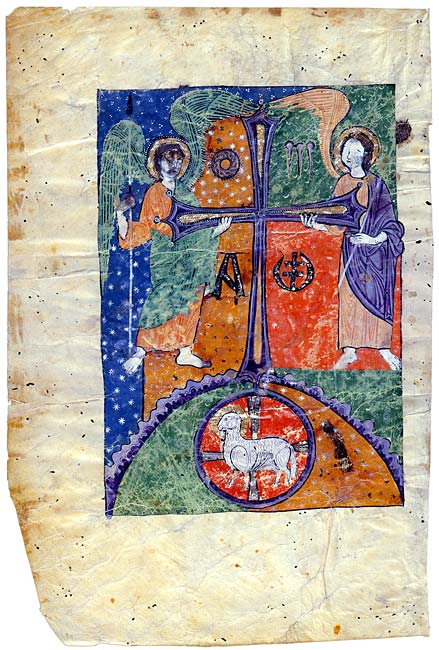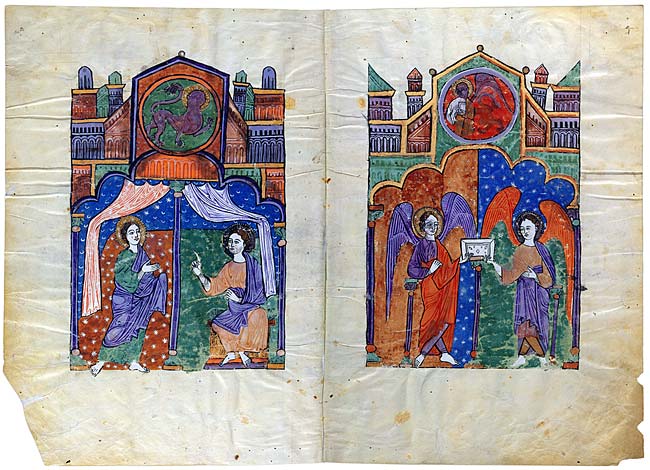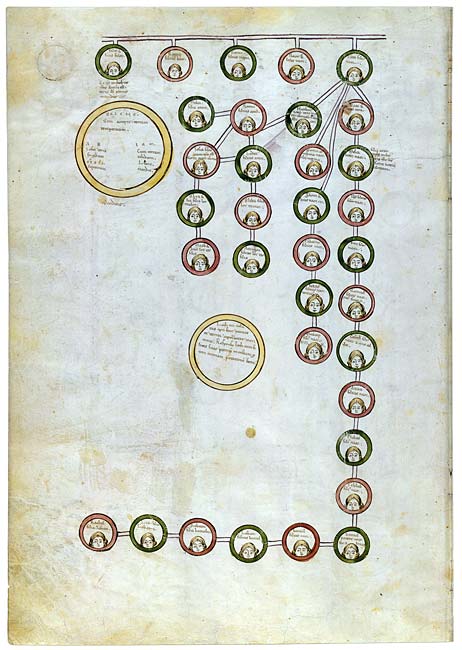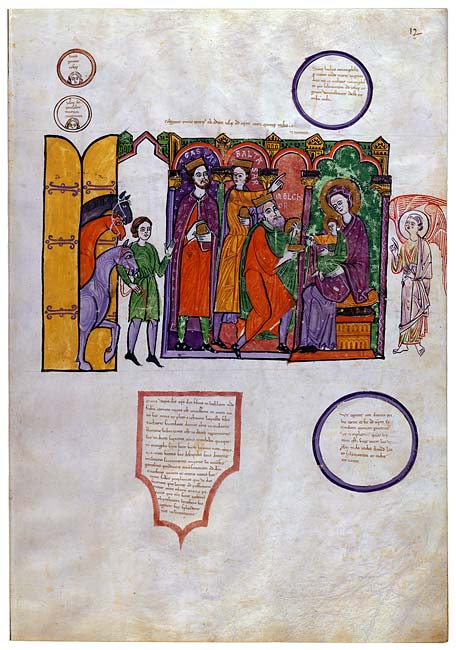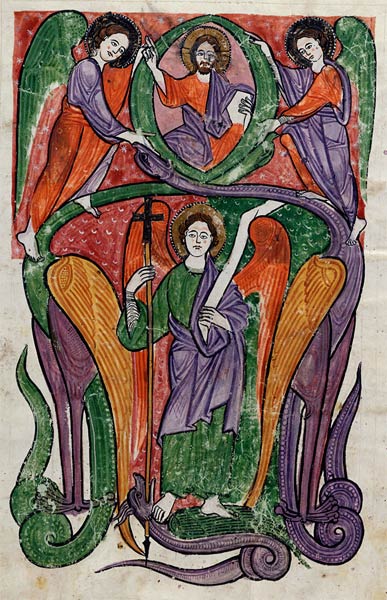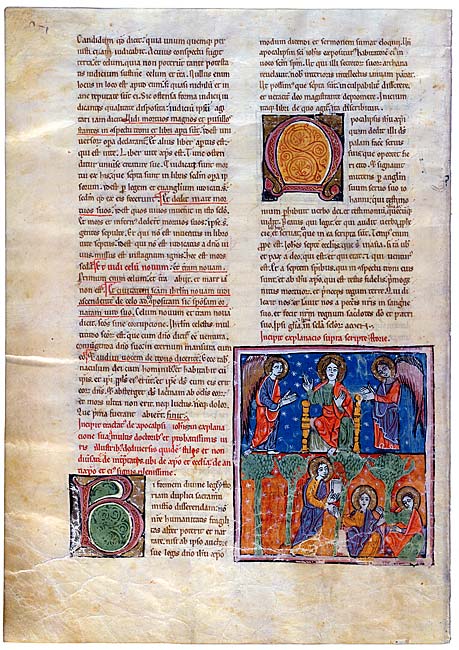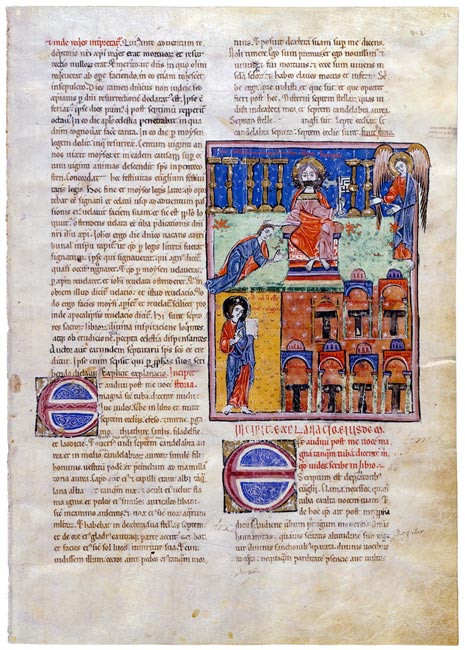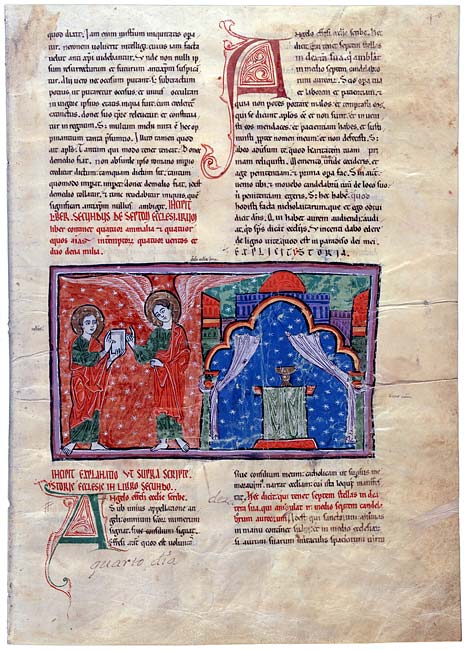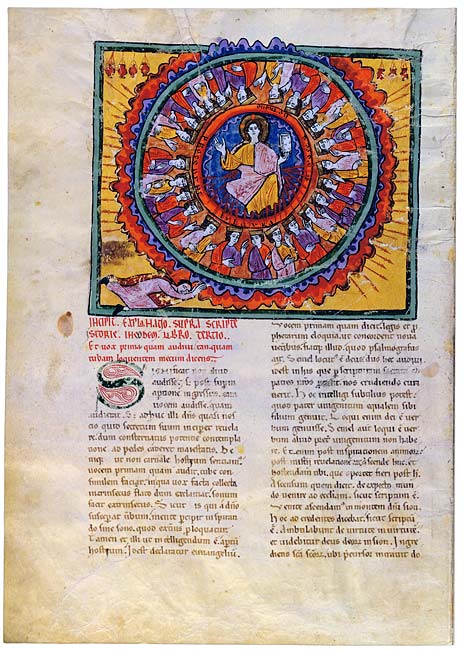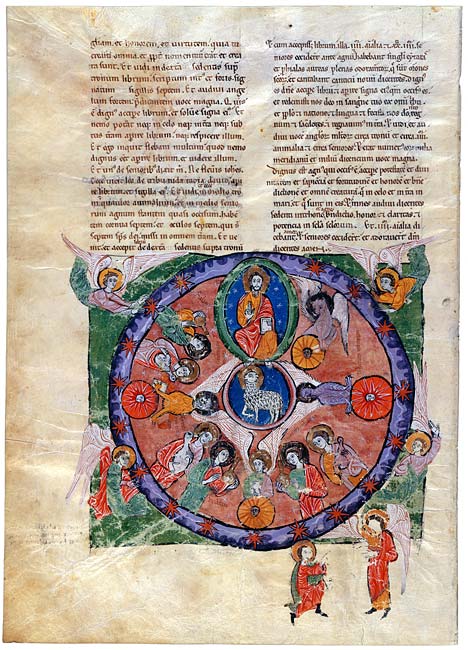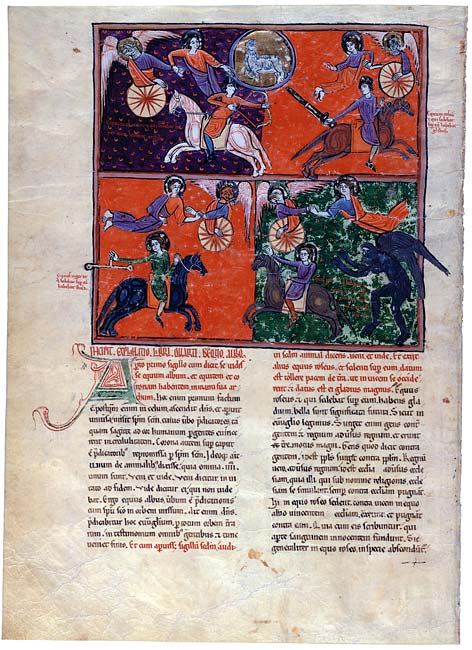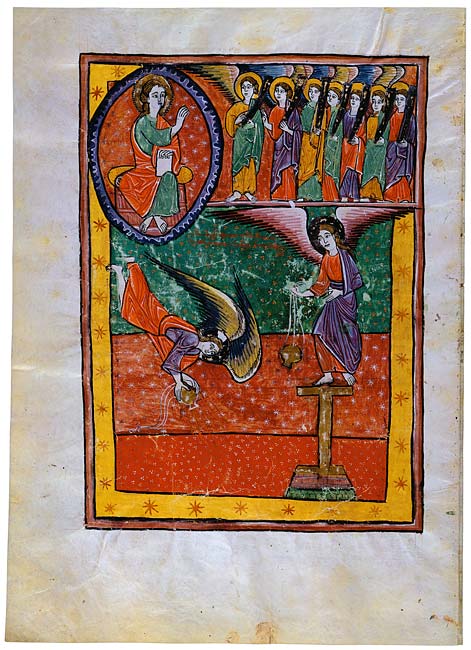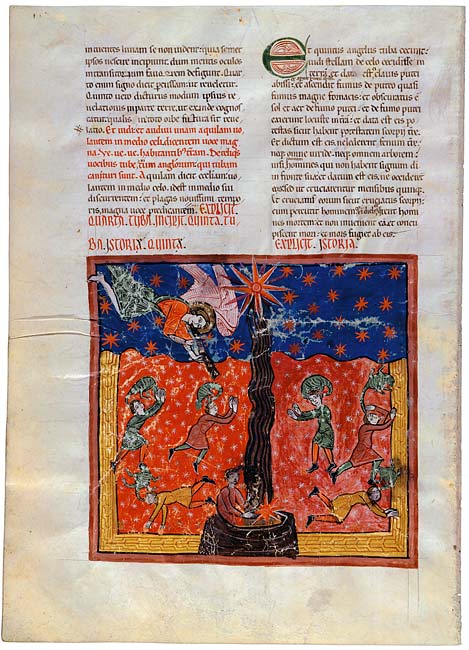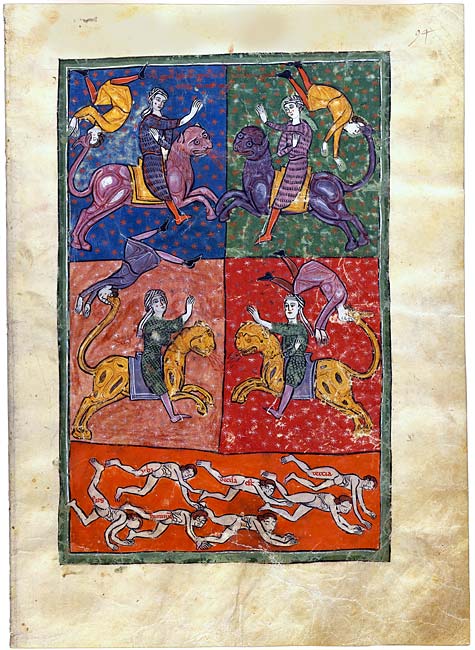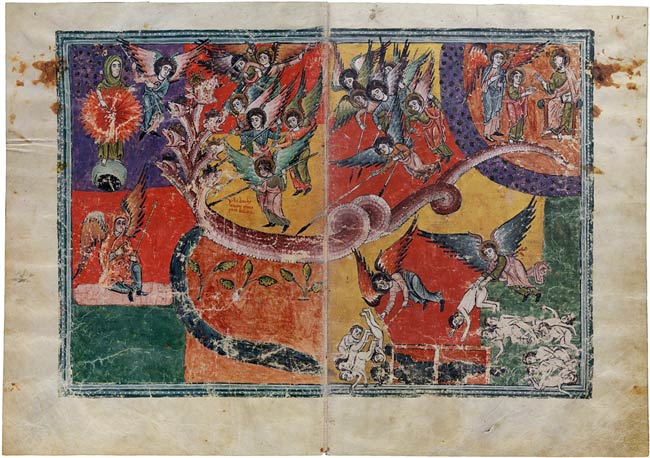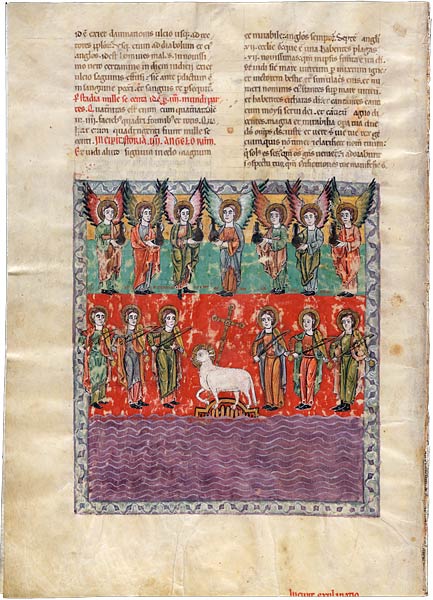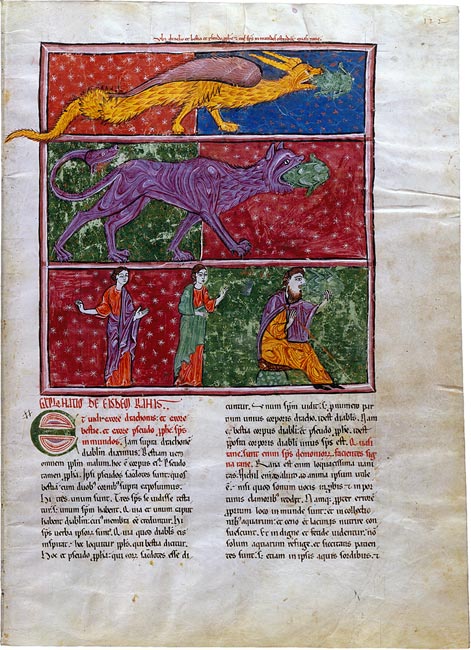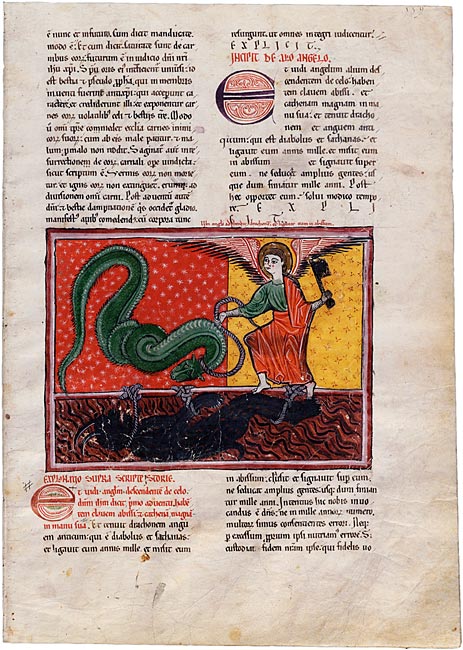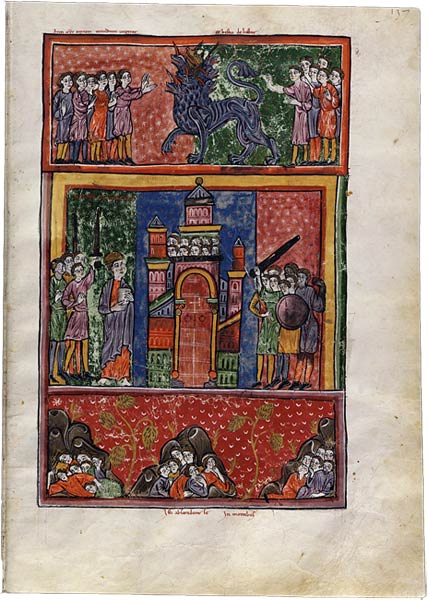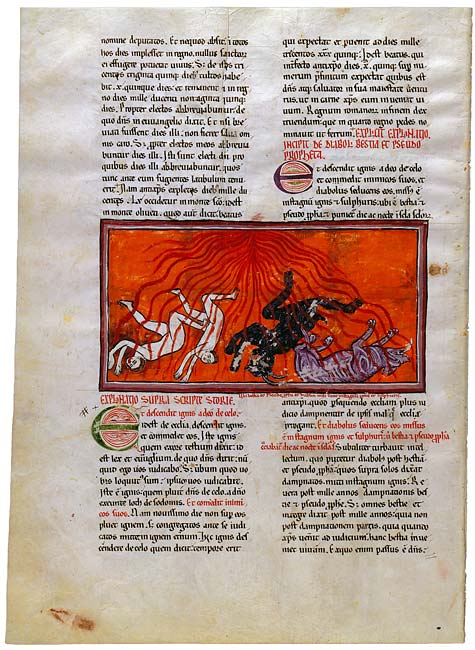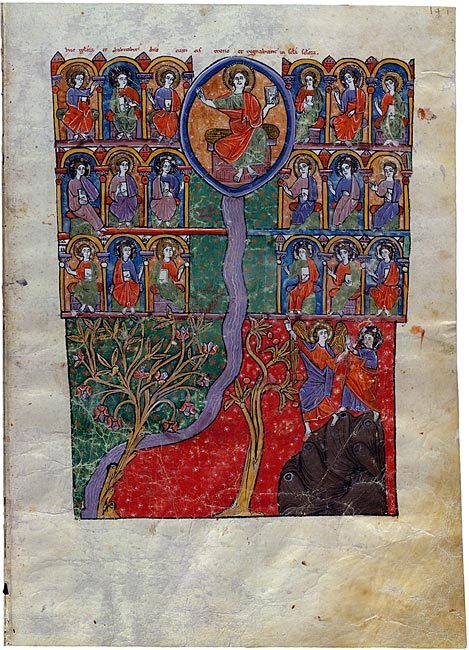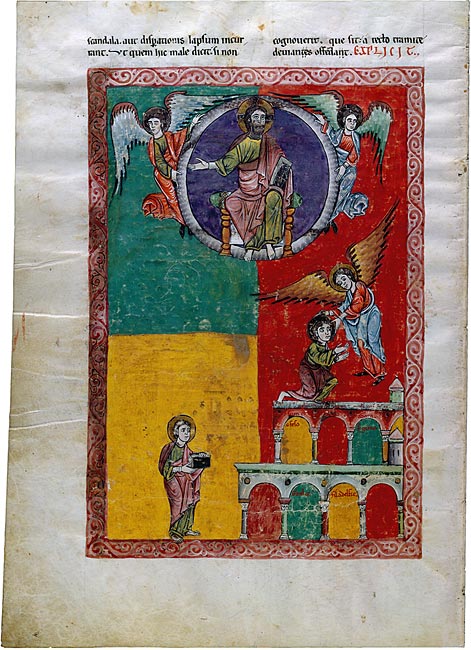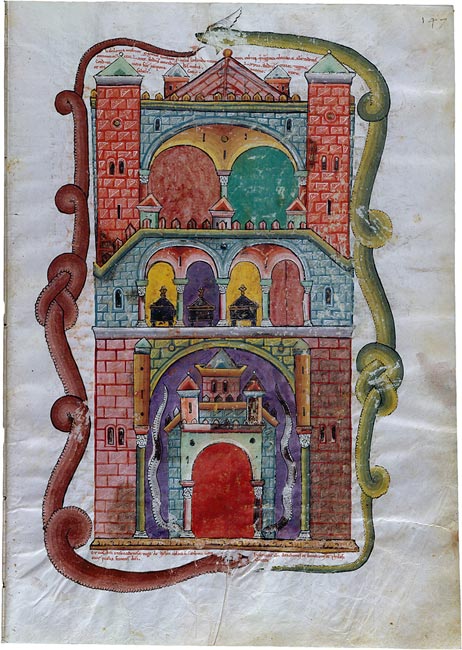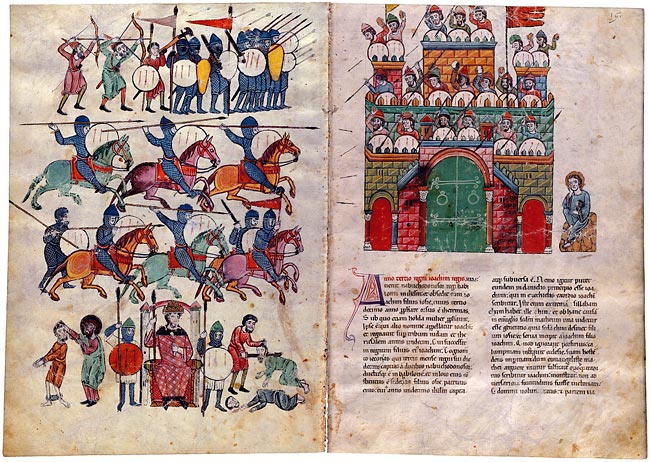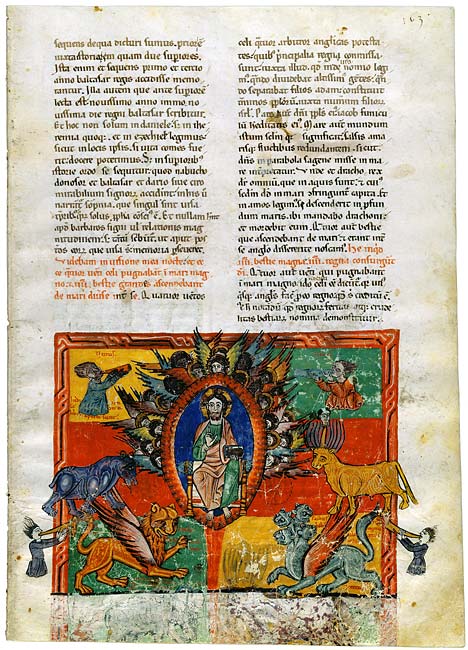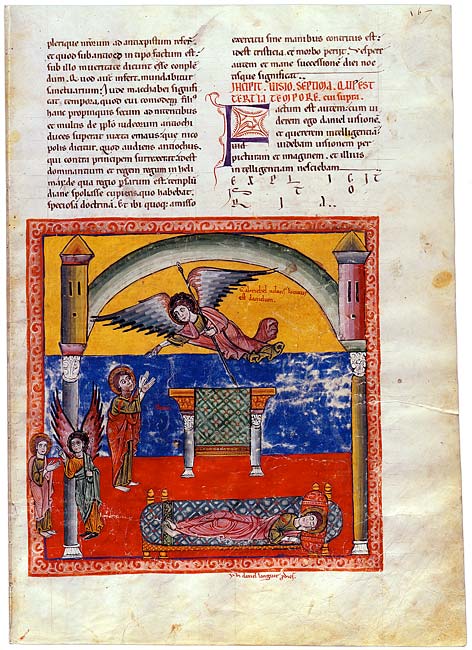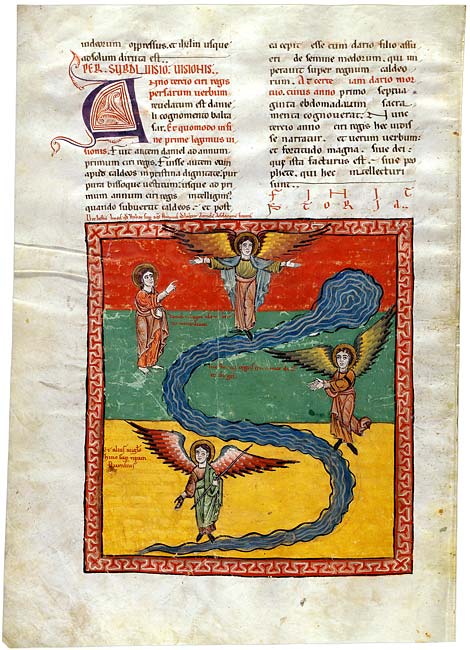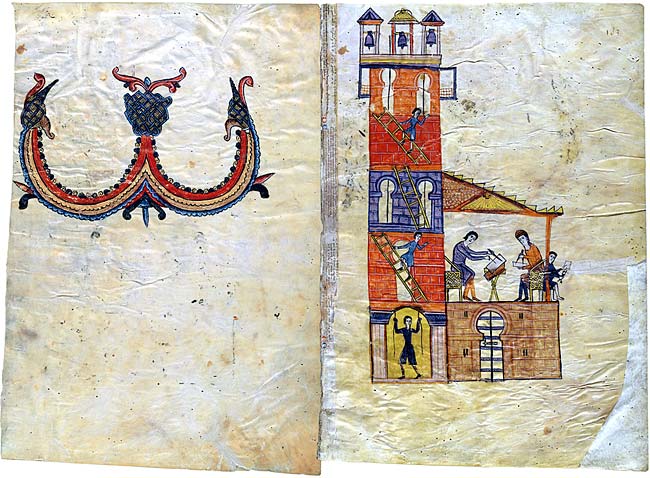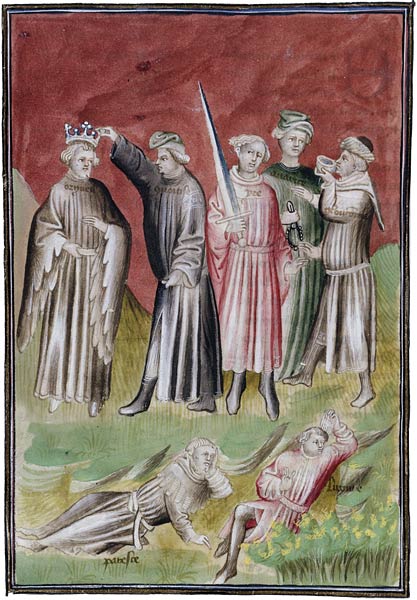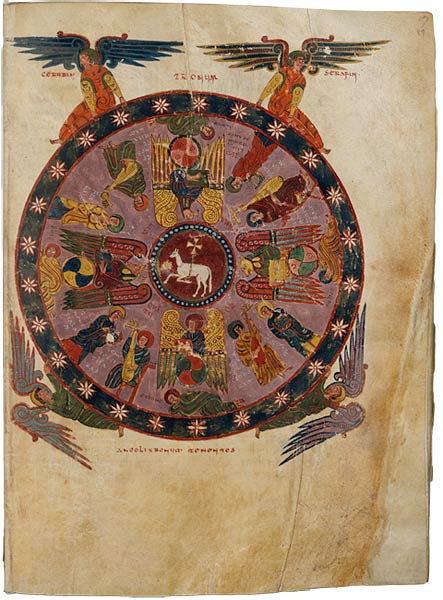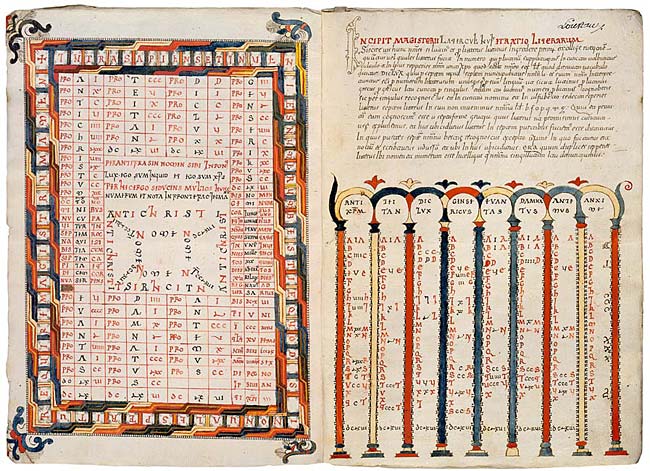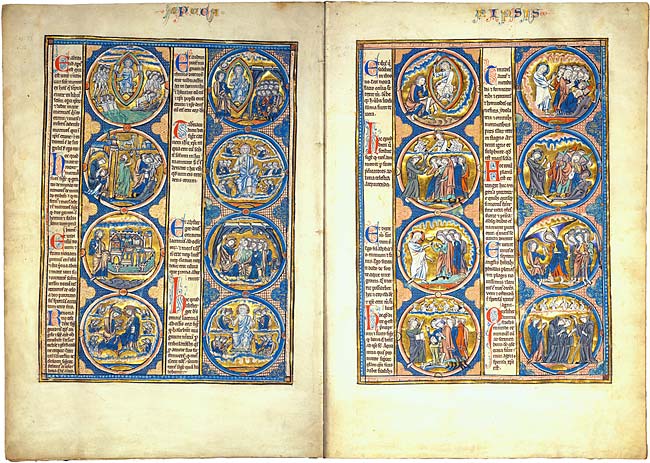Apocalypse Then: Medieval Illuminations from the Morgan
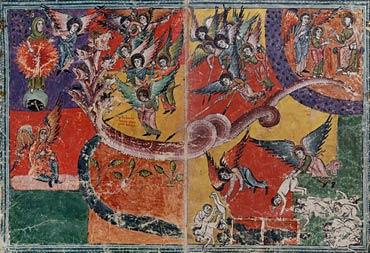
The Apocalypse, or Book of Revelation, is not only the last Book of the New Testament, but its most difficult, puzzling, and terrifying. It provided challenges to medieval illustrators and was the source for a number of popular images, such as Christ in Majesty, the Adoration of the Lamb, and the Madonna of the Apocalypse and contributed to the widespread use of the Evangelists' symbols.
Selected images from Apocalypse Then: Medieval Illuminations from the Morgan, an exhibition held at the Morgan are presented here. The exhibition celebrates the completion of a facsimile of the Morgan's Las Huelgas Apocalypse—the latest dated (1220) and largest surviving manuscript of a Spanish tradition of illuminated commentaries on the Apocalypse by the monk Beatus of Liébana. The series of manuscripts constitutes Spain's most important contribution to medieval manuscript illumination.
The Las Huelgas Apocalypse contains three sections: the prefatory cycle, the Apocalypse, and the Book of Daniel.
In addition to forty-nine images from the Las Huelgas Apocalypse, six images from other manuscripts in the Morgan's collections, including the earliest Beatus painted by Maius and one by the Master of the Berry Apocalypse, are in this presentation.
Overview
Las Huelgas Apocalypse
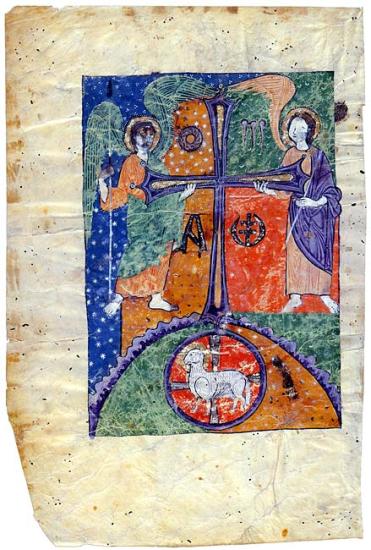
Victorious Cross Of Oviedo
Beatus of Liébana
Las Huelgas Apocalypse
Purchased by Pierpont Morgan, 1910
Many Beatus manuscripts begin with a full-page Cross of Oviedo, so named after Greek-shaped crosses in the treasury of Oviedo Cathedral that were thought to imitate the cross carried by Pelayo of Asturias in his 722 victory over the Moors at the battle of Covadonga. (Pelayo's battle was regarded as the beginning of the Christian Reconquista.) Here, however, the political symbolism of the cross has become blended with that of the Passion. Angels hold a Latin cross, spear, and sponge. More instruments of the Passion, the crown of thorns and the three nails, float above, while the Greek letters, alpha and omega, unattached to the arms of the cross, hover below. The Greek cross does appear with the Lamb in the roundel at the bottom.
PREFATORY CYCLE
Maius, who about 945 illuminated the earliest complete Beatus is credited with the idea of adding a cycle of Christological miniatures before the Apocalypse section. Here the cycle begins with the Oviedo Cross and Christ in Majesty, followed by eight pages devoted to the evangelists and their symbols. Then comes a long genealogy of Christ, beginning with Adam and Eve. In the final miniature St. Michael triumphs over Satan.
The artist responsible for these eighteen miniatures has been named the Master of the Prefatory Pages. He is thought to have been active in Toledo because of similarities found with miniatures in a copy of St. Ildefonsus's Treatise on the Virginity of Mary, now in Madrid (cod. 21546). Ildefonsus (d. 667) was the archbishop of Toledo.
The Apocalypse, or Book of Revelation, is not only the last Book of the New Testament, but its most difficult, puzzling, and terrifying. It provided challenges to medieval illustrators and was the source for a number of popular images, such as Christ in Majesty, the Adoration of the Lamb, and the Madonna of the Apocalypse and contributed to the widespread use of the Evangelists' symbols.
Selected images from Apocalypse Then: Medieval Illuminations from the Morgan, an exhibition held at the Morgan are presented here. The exhibition celebrates the completion of a facsimile of the Morgan's Las Huelgas Apocalypse—the latest dated (1220) and largest surviving manuscript of a Spanish tradition of illuminated commentaries on the Apocalypse by the monk Beatus of Liébana. The series of manuscripts constitutes Spain's most important contribution to medieval manuscript illumination.
The Las Huelgas Apocalypse contains three sections: the prefatory cycle, the Apocalypse, and the Book of Daniel.
In addition to forty-nine images from the Las Huelgas Apocalypse, six images from other manuscripts in the Morgan's collections, including the earliest Beatus painted by Maius and one by the Master of the Berry Apocalypse, are in this presentation.
Fol. 2

Christ In Majesty
Beatus of Liébana
Las Huelgas Apocalypse
Purchased by Pierpont Morgan, 1910
At the Second Coming, Christ will arrive in all his glory, seated on a throne. Here, with an imperial gesture, the returning Savior holds a book inscribed Ego sum alpha et omega (I am the Alpha and Omega). Angels support Christ's mandorla; in the four corners, anthropomorphic representations of the evangelists sit at desks. Each has a scroll with his name. The faces on the human bodies are the four living creatures of the Apocalypse that Jerome connected with the evangelists: the man represents Matthew; the eagle, John; the ox, Luke; and the lion, Mark.
The Apocalypse, or Book of Revelation, is not only the last Book of the New Testament, but its most difficult, puzzling, and terrifying. It provided challenges to medieval illustrators and was the source for a number of popular images, such as Christ in Majesty, the Adoration of the Lamb, and the Madonna of the Apocalypse and contributed to the widespread use of the Evangelists' symbols.
Selected images from Apocalypse Then: Medieval Illuminations from the Morgan, an exhibition held at the Morgan are presented here. The exhibition celebrates the completion of a facsimile of the Morgan's Las Huelgas Apocalypse—the latest dated (1220) and largest surviving manuscript of a Spanish tradition of illuminated commentaries on the Apocalypse by the monk Beatus of Liébana. The series of manuscripts constitutes Spain's most important contribution to medieval manuscript illumination.
The Las Huelgas Apocalypse contains three sections: the prefatory cycle, the Apocalypse, and the Book of Daniel.
In addition to forty-nine images from the Las Huelgas Apocalypse, six images from other manuscripts in the Morgan's collections, including the earliest Beatus painted by Maius and one by the Master of the Berry Apocalypse, are in this presentation.
Fols. 3v–4
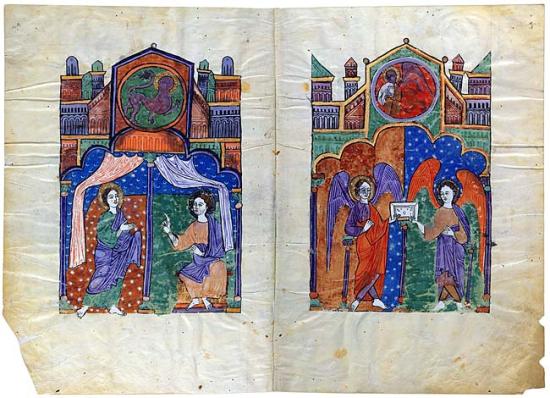
Evangelist Mark With Witness And Two Angels Holding His Gospel
Beatus of Liébana
Las Huelgas Apocalypse
Purchased by Pierpont Morgan, 1910
Maius, who illuminated the Morgan's tenth-century Beatus (exhibited in the center of the room), has been credited with the idea of adding prefatory miniatures to the Apocalypse commentary. The four double-page spreads with evangelist portraits may have been included to suggest that the Apocalypse had the same authority as the Gospels. Here, the images for Mark follow the same unusual scheme as for the other evangelists. Mark is standing on the left before a seated figure, either a witness or, as in some manuscripts, Christ. In the roundel at the top is a lion, Mark's symbol. On the opposite page, two angels hold Mark's Gospel. In the roundel above is an anthropomorphic lion, Mark's symbol; the artist seems to have changed his mind, adding a human body over the lion's.
The Apocalypse, or Book of Revelation, is not only the last Book of the New Testament, but its most difficult, puzzling, and terrifying. It provided challenges to medieval illustrators and was the source for a number of popular images, such as Christ in Majesty, the Adoration of the Lamb, and the Madonna of the Apocalypse and contributed to the widespread use of the Evangelists' symbols.
Selected images from Apocalypse Then: Medieval Illuminations from the Morgan, an exhibition held at the Morgan are presented here. The exhibition celebrates the completion of a facsimile of the Morgan's Las Huelgas Apocalypse—the latest dated (1220) and largest surviving manuscript of a Spanish tradition of illuminated commentaries on the Apocalypse by the monk Beatus of Liébana. The series of manuscripts constitutes Spain's most important contribution to medieval manuscript illumination.
The Las Huelgas Apocalypse contains three sections: the prefatory cycle, the Apocalypse, and the Book of Daniel.
In addition to forty-nine images from the Las Huelgas Apocalypse, six images from other manuscripts in the Morgan's collections, including the earliest Beatus painted by Maius and one by the Master of the Berry Apocalypse, are in this presentation.
Fol. 8v
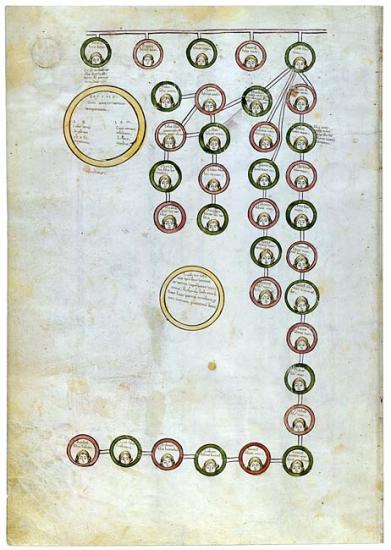
Genealogical Tables: Tare's Descendants
Beatus of Liébana
Las Huelgas Apocalypse
Purchased by Pierpont Morgan, 1910
Shown here is the genealogical table tracing the descendants of Tare, son of Macor and father of Abraham. The small roundel at top left depicts Peleg ("Falec"), Shem's great-grandson. Shem's connection with Noah explains why the large yellow circle below contains a small world map representing the three parts of the world inhabited by Noah's sons. Shem and his descendants occupied the top half, Asia, with its warm weather (terram temperatam). Japheth and his tribe lived in the cold (frigidam) of northern Europe (left), while Ham settled in hot (calidam) Africa (right; the inscription mentions Libya). The small roundel at top right is inscribed Tara filius naor (Tare, son of Macor). The roundel at bottom right is inscribed Baruel, who was the father of Rebecca, shown three roundels to the left.
The Apocalypse, or Book of Revelation, is not only the last Book of the New Testament, but its most difficult, puzzling, and terrifying. It provided challenges to medieval illustrators and was the source for a number of popular images, such as Christ in Majesty, the Adoration of the Lamb, and the Madonna of the Apocalypse and contributed to the widespread use of the Evangelists' symbols.
Selected images from Apocalypse Then: Medieval Illuminations from the Morgan, an exhibition held at the Morgan are presented here. The exhibition celebrates the completion of a facsimile of the Morgan's Las Huelgas Apocalypse—the latest dated (1220) and largest surviving manuscript of a Spanish tradition of illuminated commentaries on the Apocalypse by the monk Beatus of Liébana. The series of manuscripts constitutes Spain's most important contribution to medieval manuscript illumination.
The Las Huelgas Apocalypse contains three sections: the prefatory cycle, the Apocalypse, and the Book of Daniel.
In addition to forty-nine images from the Las Huelgas Apocalypse, six images from other manuscripts in the Morgan's collections, including the earliest Beatus painted by Maius and one by the Master of the Berry Apocalypse, are in this presentation.
Fol. 9v
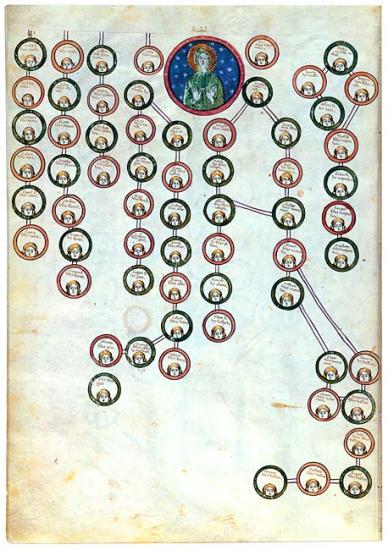
Genealogical Tables: Rachel And Jacob's Descendants
Beatus of Liébana
Las Huelgas Apocalypse
Purchased by Pierpont Morgan, 1910
Following the evangelist portraits is an elaborate series of genealogical tables tracing Christ's lineage, beginning with Adam and Eve. This chart features Rachel in the large circle at top. In the roundel touching Rachel's to the right is Jacob, who finally managed, after fourteen years, to marry her. Descending from Jacob are two roundels with the names of his sons, Joseph the Dreamer (left) and Benjamin (right).
The Apocalypse, or Book of Revelation, is not only the last Book of the New Testament, but its most difficult, puzzling, and terrifying. It provided challenges to medieval illustrators and was the source for a number of popular images, such as Christ in Majesty, the Adoration of the Lamb, and the Madonna of the Apocalypse and contributed to the widespread use of the Evangelists' symbols.
Selected images from Apocalypse Then: Medieval Illuminations from the Morgan, an exhibition held at the Morgan are presented here. The exhibition celebrates the completion of a facsimile of the Morgan's Las Huelgas Apocalypse—the latest dated (1220) and largest surviving manuscript of a Spanish tradition of illuminated commentaries on the Apocalypse by the monk Beatus of Liébana. The series of manuscripts constitutes Spain's most important contribution to medieval manuscript illumination.
The Las Huelgas Apocalypse contains three sections: the prefatory cycle, the Apocalypse, and the Book of Daniel.
In addition to forty-nine images from the Las Huelgas Apocalypse, six images from other manuscripts in the Morgan's collections, including the earliest Beatus painted by Maius and one by the Master of the Berry Apocalypse, are in this presentation.
Fol. 12
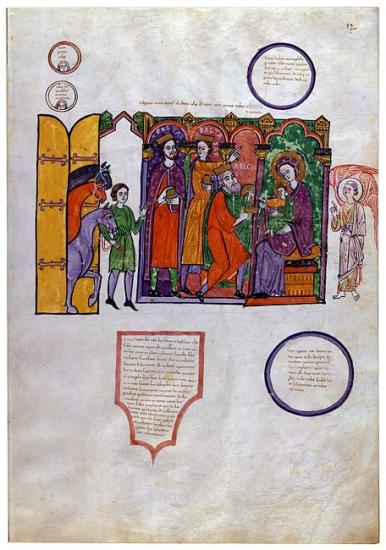
Genealogical Tables: Christ's Direct Ancestors And The Adoration Of The Magi
Beatus of Liébana
Las Huelgas Apocalypse
Purchased by Pierpont Morgan, 1910
The last tables cover the period from the Babylonian Exile to the Incarnation of Christ. At the top of the last table, in the two small unconnected roundels, we read Jacob genuit Josep (Jacob begat Joseph) and Josep disponsabit mariam virginem (Joseph betrothed to Virgin Mary). Below is Christ, on Mary's lap, adored by the Magi, an act symbolizing public recognition of the Savior. By the third century the Magi were redefined as kings, and by the ninth century they were given the familiar names of Caspar, Balthazar, and Melchior. The inscription in the circle below the Madonna states that the Lion of Judah, from the root of David, will conquer, and that to the left describes Christ's life and Passion, thus underscoring that the fruit of this genealogy will result in humanity's redemption.
The Apocalypse, or Book of Revelation, is not only the last Book of the New Testament, but its most difficult, puzzling, and terrifying. It provided challenges to medieval illustrators and was the source for a number of popular images, such as Christ in Majesty, the Adoration of the Lamb, and the Madonna of the Apocalypse and contributed to the widespread use of the Evangelists' symbols.
Selected images from Apocalypse Then: Medieval Illuminations from the Morgan, an exhibition held at the Morgan are presented here. The exhibition celebrates the completion of a facsimile of the Morgan's Las Huelgas Apocalypse—the latest dated (1220) and largest surviving manuscript of a Spanish tradition of illuminated commentaries on the Apocalypse by the monk Beatus of Liébana. The series of manuscripts constitutes Spain's most important contribution to medieval manuscript illumination.
The Las Huelgas Apocalypse contains three sections: the prefatory cycle, the Apocalypse, and the Book of Daniel.
In addition to forty-nine images from the Las Huelgas Apocalypse, six images from other manuscripts in the Morgan's collections, including the earliest Beatus painted by Maius and one by the Master of the Berry Apocalypse, are in this presentation.
Fol. 13
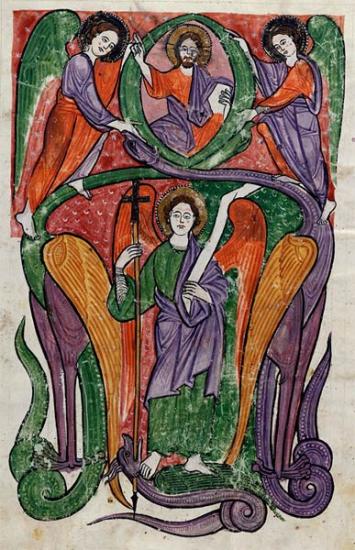
St. Michael Slaying Dragon, Christ in Majesty Above
Beatus of Liébana
Las Huelgas Apocalypse
Purchased by Pierpont Morgan, 1910
This, the finest miniature of the prefatory cycle, serves as a frontispiece for the Apocalypse itself. It is a novel feature of the Las Huelgas Apocalypse and proclaims, from the beginning, the glorious victory of Christ over Satan, an idea reinforced by the apotheosis imagery at the top, where two angels support the blessing Christ in a shieldlike mandorla. They stand on the necks of two fantastic winged creatures flanking Michael, whose heads support Christ's mandorla. The battle between Michael and the Dragon is the subject of chapter twelve of the Apocalypse, and commentators equated Michael with Christ, stating that the dragon (Satan) was defeated by the blood of the Lamb, that is, Christ's Passion, Death, and Resurrection.
APOCALYPSE
The Apocalypse, or Book of Revelation, is not only the last book of the New Testament, it is also its most difficult, puzzling, and terrifying. According to the text, it was written on the island of Patmos by a Christian prophet named John, who, from the second century on, was identified with the "beloved" apostle of Christ and the author of the fourth Gospel. Dionysius (d. ca. 264), bishop of Alexandria, and others, however, rejected the identification on the basis of style and content, a conclusion shared by most biblical scholars. The Eastern Church, for over a thousand years, regarded the Apocalypse as heretical, excluding it from the Bible. Martin Luther considered it neither apostolic nor prophetic and could in no way detect that the Holy Spirit produced it. The apostles, he said, deal in clear and plain words, and thus there are far better books. Given the Apocalypse's hostile attitude to Rome, dates from the reign of Emperor Nero (54–68) or, more often, Domitian (81–96) have been proposed; they both persecuted Christians. A much earlier date for chapters 4–12 has been suggested by J. Massyngberde Ford, who attributed them to John the Baptist and proposed that the first three chapters were added after A.D. 60 to "Christianize" the text. The interpretation of the book is also problematic, and over the last two millennia each age seemed to offer its own. Whereas medieval apocalypticism was primarily religious, that of our own day added a secular, often negative note, including such things as the AIDS epidemic, the Y2K "bug," global warming, and terrorist attacks. The Greek word apocalypse, meaning "revelation," has become synonymous with catastrophe. Despite the fact that the text itself suggests that what would happen was imminent (Jesus himself said the Second Coming was soon), and that every prediction up to 2000 remains unfulfilled, this has not deterred some from making new ones. Beatus wrote his commentary to prepare his fellow monks for the end he believe would arrive in 800, but he may also have survived his prophecy. Eschatological predictions, alas, overshadow the book's positive meaning, that the forces of evil will be overcome and that the righteous and faithful will be victorious, receiving their reward in heavenly Jerusalem. Most of the miniatures in the Las Huelgas Apocalypse section are by an artist, perhaps an assistant, whose origins are less clear. The Master of Toledo, who painted the Daniel scenes, executed the seven miniatures beginning on folio 100 as well as the final Apocalypse miniature (fol. 146v). Beatus divided the text into sixty-eight short sections, each with a lengthy commentary (a storia and explanatio); the miniatures follow and usually illustrate the storia.
The Apocalypse, or Book of Revelation, is not only the last Book of the New Testament, but its most difficult, puzzling, and terrifying. It provided challenges to medieval illustrators and was the source for a number of popular images, such as Christ in Majesty, the Adoration of the Lamb, and the Madonna of the Apocalypse and contributed to the widespread use of the Evangelists' symbols.
Selected images from Apocalypse Then: Medieval Illuminations from the Morgan, an exhibition held at the Morgan are presented here. The exhibition celebrates the completion of a facsimile of the Morgan's Las Huelgas Apocalypse—the latest dated (1220) and largest surviving manuscript of a Spanish tradition of illuminated commentaries on the Apocalypse by the monk Beatus of Liébana. The series of manuscripts constitutes Spain's most important contribution to medieval manuscript illumination.
The Las Huelgas Apocalypse contains three sections: the prefatory cycle, the Apocalypse, and the Book of Daniel.
In addition to forty-nine images from the Las Huelgas Apocalypse, six images from other manuscripts in the Morgan's collections, including the earliest Beatus painted by Maius and one by the Master of the Berry Apocalypse, are in this presentation.
Fol. 19v
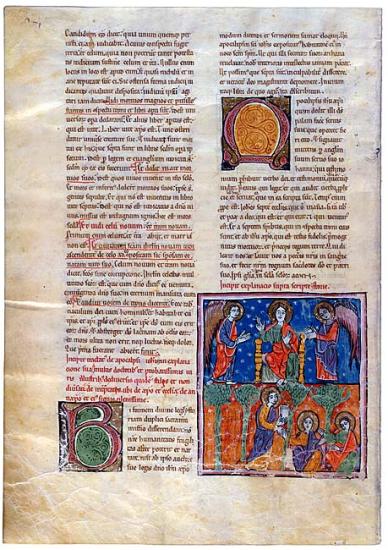
God Sends The Angel With The Book To John
Beatus of Liébana
Las Huelgas Apocalypse
Purchased by Pierpont Morgan, 1910
The Revelation of Jesus Christ, which God gave to him, in order to make known to his servants the things which must soon occur, and which he signified by sending his angel to his servant John; he has offered testimony to the Word of God, and whatever he sawis the testimony of Jesus Christ. Blessed is he who reads or hears the words of this prophecy, and who keeps the things that have been written in it. For the time is near. (Rev. 1:1–3)
The miniature is unusual because of its small size; a large one generally opens the Apocalypse text. An enthroned God offers a blessing while, below, the Book of Revelation is delivered to John, along with a handshake.
The Apocalypse, or Book of Revelation, is not only the last Book of the New Testament, but its most difficult, puzzling, and terrifying. It provided challenges to medieval illustrators and was the source for a number of popular images, such as Christ in Majesty, the Adoration of the Lamb, and the Madonna of the Apocalypse and contributed to the widespread use of the Evangelists' symbols.
Selected images from Apocalypse Then: Medieval Illuminations from the Morgan, an exhibition held at the Morgan are presented here. The exhibition celebrates the completion of a facsimile of the Morgan's Las Huelgas Apocalypse—the latest dated (1220) and largest surviving manuscript of a Spanish tradition of illuminated commentaries on the Apocalypse by the monk Beatus of Liébana. The series of manuscripts constitutes Spain's most important contribution to medieval manuscript illumination.
The Las Huelgas Apocalypse contains three sections: the prefatory cycle, the Apocalypse, and the Book of Daniel.
In addition to forty-nine images from the Las Huelgas Apocalypse, six images from other manuscripts in the Morgan's collections, including the earliest Beatus painted by Maius and one by the Master of the Berry Apocalypse, are in this presentation.
Fol. 22
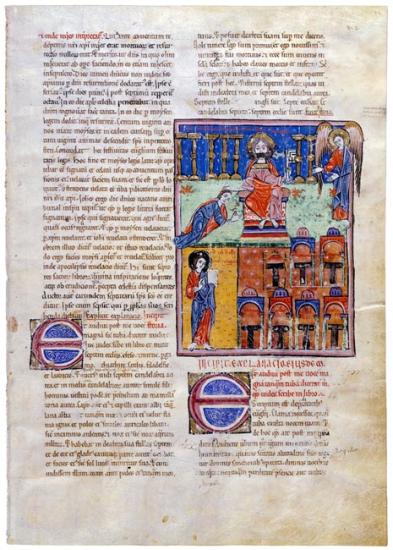
Vision Of The Seven Candlesticks And The Son Of Man
Beatus of Liébana
Las Huelgas Apocalypse
Purchased by Pierpont Morgan, 1910
And I turned around to see the voice which was speaking with me, and I saw seven golden candlesticks: in the midst of the candlesticks was one resembling the son of man, clothed to the feet with a vestment, and wrapped to the breast with a wide belt of gold. But his head and hair were bright, like white wool, or like snow; and his eyes were like a flame of fire. And in his right hand he held the seven stars; and from his mouth went out a sharp two-edged sword. I fell at his feet as dead, and he laid his right hand upon me, saying: "Do not be afraid. I am the First and the Last, and alive, though I was dead. And behold, I live forever and ever, and hold the keys of death and of hell. Therefore, write the things which you have seen, and which are, and which must occur afterward. The seven stars are the angels of the seven Churches, and the seven candlesticks are the seven Churches." (Rev. 1:12–20)
The son of man's tunic is gold at the neck, and the sword in his mouth is silver. Most of the red stars have flaked off. Below, John holds a book or letter, while to the right are the seven churches, each identified with a red inscription (Ephesus, Smyrna, Pergamum, Thyatira, Sardis, Philadelphia, and Laodicea).
The Apocalypse, or Book of Revelation, is not only the last Book of the New Testament, but its most difficult, puzzling, and terrifying. It provided challenges to medieval illustrators and was the source for a number of popular images, such as Christ in Majesty, the Adoration of the Lamb, and the Madonna of the Apocalypse and contributed to the widespread use of the Evangelists' symbols.
Selected images from Apocalypse Then: Medieval Illuminations from the Morgan, an exhibition held at the Morgan are presented here. The exhibition celebrates the completion of a facsimile of the Morgan's Las Huelgas Apocalypse—the latest dated (1220) and largest surviving manuscript of a Spanish tradition of illuminated commentaries on the Apocalypse by the monk Beatus of Liébana. The series of manuscripts constitutes Spain's most important contribution to medieval manuscript illumination.
The Las Huelgas Apocalypse contains three sections: the prefatory cycle, the Apocalypse, and the Book of Daniel.
In addition to forty-nine images from the Las Huelgas Apocalypse, six images from other manuscripts in the Morgan's collections, including the earliest Beatus painted by Maius and one by the Master of the Berry Apocalypse, are in this presentation.
Fols. 31v-32
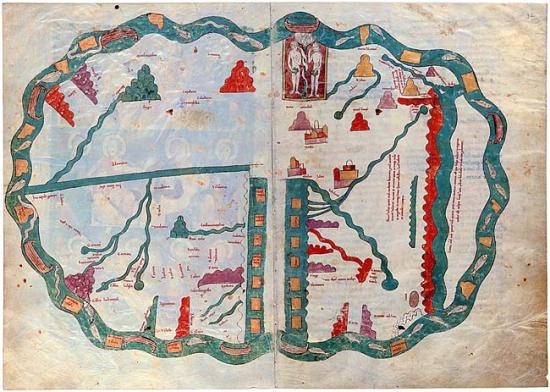
The World Map
Beatus of Liébana
Las Huelgas Apocalypse
Purchased by Pierpont Morgan, 1910
This double-page world map is one of the manuscript's most intriguing illustrations. It is not called for by the Apocalypse text itself but is alluded to by Beatus, who writes about the various regions the twelve apostles were to evangelize (Peter, for example, went to Rome, Andrew to Acaya, Thomas to India, James to Spain, and John to Asia). The two vertical green areas on either side of the gutter represent the Mediterranean Sea (the yellow rectangles are islands, such as Crete and Corsica). Europe is at the bottom left. In Spain, only Andalusia (Betica), Asturias, and Saragossa (Cesaraugusta) are listed. Africa is at the bottom right page, while Asia fills the top half of both pages. Below Adam and Eve in paradise are Jerusalem and Mt. Sinai, and lower down are Judea and Babylonia.
The Apocalypse, or Book of Revelation, is not only the last Book of the New Testament, but its most difficult, puzzling, and terrifying. It provided challenges to medieval illustrators and was the source for a number of popular images, such as Christ in Majesty, the Adoration of the Lamb, and the Madonna of the Apocalypse and contributed to the widespread use of the Evangelists' symbols.
Selected images from Apocalypse Then: Medieval Illuminations from the Morgan, an exhibition held at the Morgan are presented here. The exhibition celebrates the completion of a facsimile of the Morgan's Las Huelgas Apocalypse—the latest dated (1220) and largest surviving manuscript of a Spanish tradition of illuminated commentaries on the Apocalypse by the monk Beatus of Liébana. The series of manuscripts constitutes Spain's most important contribution to medieval manuscript illumination.
The Las Huelgas Apocalypse contains three sections: the prefatory cycle, the Apocalypse, and the Book of Daniel.
In addition to forty-nine images from the Las Huelgas Apocalypse, six images from other manuscripts in the Morgan's collections, including the earliest Beatus painted by Maius and one by the Master of the Berry Apocalypse, are in this presentation.
Fol. 40
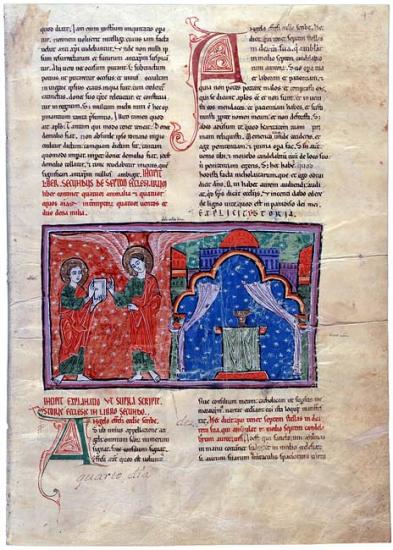
Letter To The Church Of Ephesus
Beatus of Liébana
Las Huelgas Apocalypse
Purchased by Pierpont Morgan, 1910
And to the Angel of the Church of Ephesus write: Thus says the One who holds the seven stars in his right hand and walks in the midst of the seven golden candlesticks: I know your works, and your hardship and patient endurance, and that you cannot stand those who are evil. And so, you have tested those who declare themselves to be Apostles and are not, and you have found them to be liars. And you have patient endurance for the sake of my name, and you have not fallen away. Whoever has an ear, let him hear what the Spirit says to the Churches. To him who prevails I will give to eat from the Tree of Life, which is in the Paradise of my God. (Rev. 2:1–7)
In the miniature John holds the letter in the form of a book before the Angel of the Church of Ephesus, the first of the seven churches in Asia Minor. The building is represented as a complex structure with towers and a dome. Curtains part to reveal a gold chalice—an allusion to the ritual of the Mass—on the altar.
he Apocalypse, or Book of Revelation, is not only the last Book of the New Testament, but its most difficult, puzzling, and terrifying. It provided challenges to medieval illustrators and was the source for a number of popular images, such as Christ in Majesty, the Adoration of the Lamb, and the Madonna of the Apocalypse and contributed to the widespread use of the Evangelists' symbols.
Selected images from Apocalypse Then: Medieval Illuminations from the Morgan, an exhibition held at the Morgan are presented here. The exhibition celebrates the completion of a facsimile of the Morgan's Las Huelgas Apocalypse—the latest dated (1220) and largest surviving manuscript of a Spanish tradition of illuminated commentaries on the Apocalypse by the monk Beatus of Liébana. The series of manuscripts constitutes Spain's most important contribution to medieval manuscript illumination.
The Las Huelgas Apocalypse contains three sections: the prefatory cycle, the Apocalypse, and the Book of Daniel.
In addition to forty-nine images from the Las Huelgas Apocalypse, six images from other manuscripts in the Morgan's collections, including the earliest Beatus painted by Maius and one by the Master of the Berry Apocalypse, are in this presentation.
Fol. 50
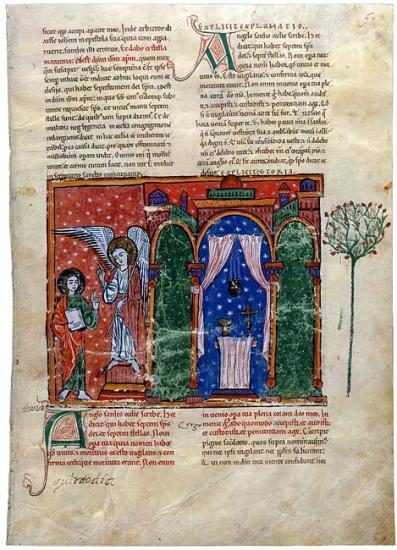
Letter To The Church Of Sardis
Beatus of Liébana
Las Huelgas Apocalypse
Purchased by Pierpont Morgan, 1910
And to the Angel of the Church of Sardis write: Thus says he who has the seven spirits of God and the seven stars: I know your works, that you have a name which is alive, but you are dead. Be vigilant, and confirm the things that remain, lest they soon die. Keep in mind the way that you have received and heard, and then observe it and repent. But if you will not be vigilant, I will come to you like a thief, and you will not know at what hour I will come to you. He that prevails will be clothed in white vestments. And I will not delete his name from the Book of Life. And I will confess his name in the presence of my Father and in the presence of his angels. (Rev. 3:1–5)
John gestures to the angel, who stands on a pediment and holds a cross staff. Compared to the previous miniature (fol. 40), the church structure and its contents are much more elaborate. The altar holds a gold chalice and cross and is lit by a hanging silver lamp. The tree to the right occurs in other Church miniatures in other manuscripts.
The Apocalypse, or Book of Revelation, is not only the last Book of the New Testament, but its most difficult, puzzling, and terrifying. It provided challenges to medieval illustrators and was the source for a number of popular images, such as Christ in Majesty, the Adoration of the Lamb, and the Madonna of the Apocalypse and contributed to the widespread use of the Evangelists' symbols.
Selected images from Apocalypse Then: Medieval Illuminations from the Morgan, an exhibition held at the Morgan are presented here. The exhibition celebrates the completion of a facsimile of the Morgan's Las Huelgas Apocalypse—the latest dated (1220) and largest surviving manuscript of a Spanish tradition of illuminated commentaries on the Apocalypse by the monk Beatus of Liébana. The series of manuscripts constitutes Spain's most important contribution to medieval manuscript illumination.
The Las Huelgas Apocalypse contains three sections: the prefatory cycle, the Apocalypse, and the Book of Daniel.
In addition to forty-nine images from the Las Huelgas Apocalypse, six images from other manuscripts in the Morgan's collections, including the earliest Beatus painted by Maius and one by the Master of the Berry Apocalypse, are in this presentation.
Fol. 59v
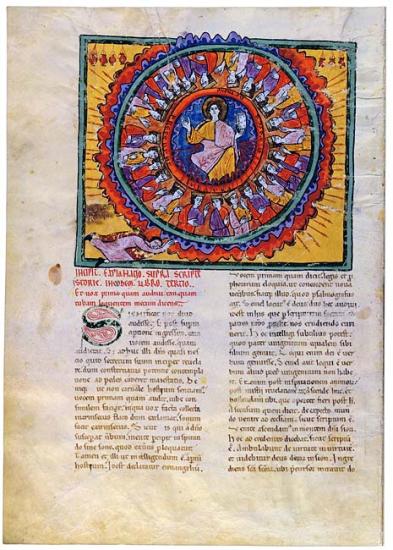
Vision Of God Enthroned
Beatus of Liébana
Las Huelgas Apocalypse
Purchased by Pierpont Morgan, 1910
After these things, I saw a door was opened in heaven, and the voice that I heard speaking with me first was like a trumpet, saying: "Ascend to here, and I will reveal to you what must occur after these things." And immediately I was in the spirit. And behold, a throne had been placed in heaven, and there was One sitting upon the throne similar in appearance to a stone of jasper and sardius. And there was an iridescence surrounding the throne, in aspect similar to an emerald. And surrounding the throne were twenty-four smaller thrones. And upon the thrones, twenty-four elders were sitting, clothed all around in white vestments, and on their heads were gold crowns. And from the throne, lightnings and voices and thunders went forth. And there were seven burning lamps before the throne, which are the seven spirits of God. (Rev. 4:1–5)
At the lower left, a trancelike John suggests that he is "in the spirit." The "One sitting upon the throne" is Christ. The red rays emanating from Christ, wavy blue and orange clouds, and jutting orange spears suggest the iridescence of the emerald.
The Apocalypse, or Book of Revelation, is not only the last Book of the New Testament, but its most difficult, puzzling, and terrifying. It provided challenges to medieval illustrators and was the source for a number of popular images, such as Christ in Majesty, the Adoration of the Lamb, and the Madonna of the Apocalypse and contributed to the widespread use of the Evangelists' symbols.
Selected images from Apocalypse Then: Medieval Illuminations from the Morgan, an exhibition held at the Morgan are presented here. The exhibition celebrates the completion of a facsimile of the Morgan's Las Huelgas Apocalypse—the latest dated (1220) and largest surviving manuscript of a Spanish tradition of illuminated commentaries on the Apocalypse by the monk Beatus of Liébana. The series of manuscripts constitutes Spain's most important contribution to medieval manuscript illumination.
The Las Huelgas Apocalypse contains three sections: the prefatory cycle, the Apocalypse, and the Book of Daniel.
In addition to forty-nine images from the Las Huelgas Apocalypse, six images from other manuscripts in the Morgan's collections, including the earliest Beatus painted by Maius and one by the Master of the Berry Apocalypse, are in this presentation.
Fol. 61v
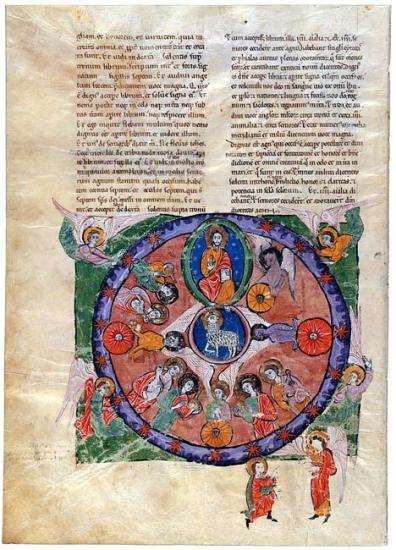
Vision Of The Lamb And The Four Living Creatures
Beatus of Liébana
Las Huelgas Apocalypse
Purchased by Pierpont Morgan, 1910
And in the middle of the throne, and all around the throne, there were four living creatures. The first resembled a lion, the second an ox, the third had a face like a man, and the fourth resembled a flying eagle. And while those living creatures were giving glory and honor and blessings to the One sitting upon the throne, the twenty-four elders fell prostrate and adored him. And in the right hand of the One sitting on the throne, I saw a book, written inside and out, sealed with seven seals. And in the midst a Lamb was standing, as if it were slain. And when the lamb received and opened the book the four living creatures and elders fell down before the Lamb, each having stringed instruments, as well as golden bowls full of fragrances, which are the prayers of the saints. And they were singing a new canticle, saying: "O Lord, you are worthy to receive the book and to open its seals, because you were slain and have redeemed us for God, by your blood." (Rev. 4:6–5:14)
The insertion of Christ with the book above the Lamb has resulted in the loss of the axial symmetry seen in the Morgan's tenth-century Beatus (exhibited nearby); the calf had to be moved to the right. At the end of the second century the four living creatures were connected with the evangelists, becoming their symbols (the man represents Matthew; the lion, Mark; the calf, Luke; the eagle, John). The creatures and fiery disks under them derive from Ezekiel's vision of the cherubim. The vision is enclosed by a starry border supported by four angels; at the lower right John converses with an angel.
The Apocalypse, or Book of Revelation, is not only the last Book of the New Testament, but its most difficult, puzzling, and terrifying. It provided challenges to medieval illustrators and was the source for a number of popular images, such as Christ in Majesty, the Adoration of the Lamb, and the Madonna of the Apocalypse and contributed to the widespread use of the Evangelists' symbols.
Selected images from Apocalypse Then: Medieval Illuminations from the Morgan, an exhibition held at the Morgan are presented here. The exhibition celebrates the completion of a facsimile of the Morgan's Las Huelgas Apocalypse—the latest dated (1220) and largest surviving manuscript of a Spanish tradition of illuminated commentaries on the Apocalypse by the monk Beatus of Liébana. The series of manuscripts constitutes Spain's most important contribution to medieval manuscript illumination.
The Las Huelgas Apocalypse contains three sections: the prefatory cycle, the Apocalypse, and the Book of Daniel.
In addition to forty-nine images from the Las Huelgas Apocalypse, six images from other manuscripts in the Morgan's collections, including the earliest Beatus painted by Maius and one by the Master of the Berry Apocalypse, are in this presentation.
Fol. 71v
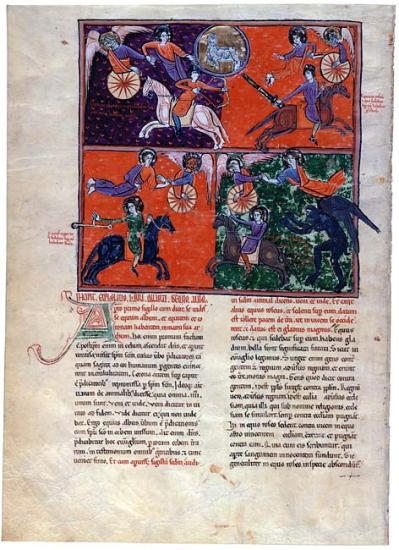
Opening Of The First Four Seals: The Four Horsemen
Beatus of Liébana
Las Huelgas Apocalypse
Purchased by Pierpont Morgan, 1910
And I saw that the Lamb had opened one of the seven seals. And I heard one of the four living creatures saying, "Draw near and see." And I saw a white horse, and the rider was holding a bow, and a crown was given to him, and he went forth conquering. And when he opened the second seal, the second living creature spoke. And a red horse went forth, and it was granted to its rider that he would take peace from the earth, and that they would kill one another. And a great sword was given to him. And when he opened the third seal, the third living creature spoke. And he saw a black horse, and its rider was holding a balance in his hand. And when he opened the fourth seal, the fourth living creature spoke. And I saw a pale horse, and the rider's name was Death, and Hell was following him. And authority was given to him over the four parts of the earth, to destroy by the sword, by famine, and by death. (Rev. 6:1–8)
As the lamb opens each of the seals, one of the living creatures takes John by the hand and lifts him into the air. Curiously, the first two horsemen seem to fight one another; they wear helmets with nose protectors. The other two horsemen have halos. Hell is shown as a hairy blue figure, deriving from the belief that demons were made of air.
The Apocalypse, or Book of Revelation, is not only the last Book of the New Testament, but its most difficult, puzzling, and terrifying. It provided challenges to medieval illustrators and was the source for a number of popular images, such as Christ in Majesty, the Adoration of the Lamb, and the Madonna of the Apocalypse and contributed to the widespread use of the Evangelists' symbols.
Selected images from Apocalypse Then: Medieval Illuminations from the Morgan, an exhibition held at the Morgan are presented here. The exhibition celebrates the completion of a facsimile of the Morgan's Las Huelgas Apocalypse—the latest dated (1220) and largest surviving manuscript of a Spanish tradition of illuminated commentaries on the Apocalypse by the monk Beatus of Liébana. The series of manuscripts constitutes Spain's most important contribution to medieval manuscript illumination.
The Las Huelgas Apocalypse contains three sections: the prefatory cycle, the Apocalypse, and the Book of Daniel.
In addition to forty-nine images from the Las Huelgas Apocalypse, six images from other manuscripts in the Morgan's collections, including the earliest Beatus painted by Maius and one by the Master of the Berry Apocalypse, are in this presentation.
Fol. 74v
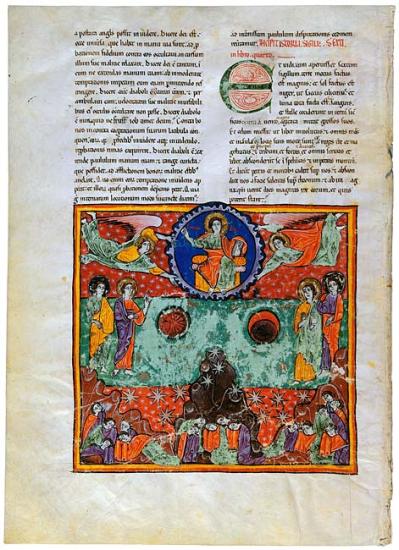
Opening Of The Sixth Seal: The Earthquake
Beatus of Liébana
Las Huelgas Apocalypse
Purchased by Pierpont Morgan, 1910
And when he had opened the sixth seal, I saw a great earthquake. And the sun became black, like a haircloth sack, and the entire moon became like blood. And the stars from heaven fell upon the earth, just as when a fig tree, shaken by a great wind, drops its immature figs. And heaven receded, like a scroll being rolled up. And every mountain, and the islands, were moved from their places. And the kings of the earth, and the rulers, and the military leaders, and the wealthy, and the strong, and everyone, servant and free, hid themselves in caves and among the rocks of the mountains. And they said to the mountains and the rocks: "Fall over us and hide us from the face of the One sitting upon the throne, and from the wrath of the Lamb. For the great day of their wrath has arrived. And who will be able to stand?" (Rev. 6:12–17)
At the top, two flying angels support the enthroned Christ in an aureole, while four elders are in attendance. The bottom part of the miniature follows the text.
The Apocalypse, or Book of Revelation, is not only the last Book of the New Testament, but its most difficult, puzzling, and terrifying. It provided challenges to medieval illustrators and was the source for a number of popular images, such as Christ in Majesty, the Adoration of the Lamb, and the Madonna of the Apocalypse and contributed to the widespread use of the Evangelists' symbols.
Selected images from Apocalypse Then: Medieval Illuminations from the Morgan, an exhibition held at the Morgan are presented here. The exhibition celebrates the completion of a facsimile of the Morgan's Las Huelgas Apocalypse—the latest dated (1220) and largest surviving manuscript of a Spanish tradition of illuminated commentaries on the Apocalypse by the monk Beatus of Liébana. The series of manuscripts constitutes Spain's most important contribution to medieval manuscript illumination.
The Las Huelgas Apocalypse contains three sections: the prefatory cycle, the Apocalypse, and the Book of Daniel.
In addition to forty-nine images from the Las Huelgas Apocalypse, six images from other manuscripts in the Morgan's collections, including the earliest Beatus painted by Maius and one by the Master of the Berry Apocalypse, are in this presentation.
Fol. 78
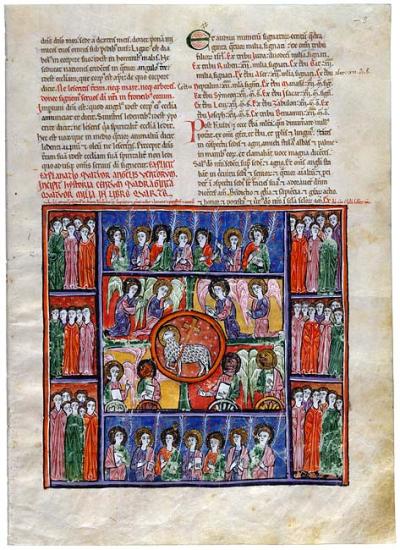
Adoration Of The Lamb, The Sealed, And The Elect
Beatus of Liébana
Las Huelgas Apocalypse
Purchased by Pierpont Morgan, 1910
And I heard the number of those who were sealed: one hundred and forty-four thousand sealed, out of every tribe of the sons of Israel. After these things, I saw a great crowd, which no one could number, from all the nations and tribes and peoples and languages, standing before the throne and in sight of the Lamb, clothed in white robes, with palm branches in their hands. And they cried out, with a great voice, saying: "Salvation is from our God, who sits upon the throne, and from the Lamb." And all the angels were standing around the throne, with the elders and the four living creatures. And they fell upon their faces in view of the throne, and they worshiped God. (Rev. 7:4–11)
The central Lamb is set against a green cross, with four adoring angels above and the four living creatures below (the latter with books). The numberless elect hold palms and have gold or silver halos, while the sealed from the tribes of Israel occupy the six outer compartments.
The Apocalypse, or Book of Revelation, is not only the last Book of the New Testament, but its most difficult, puzzling, and terrifying. It provided challenges to medieval illustrators and was the source for a number of popular images, such as Christ in Majesty, the Adoration of the Lamb, and the Madonna of the Apocalypse and contributed to the widespread use of the Evangelists' symbols.
Selected images from Apocalypse Then: Medieval Illuminations from the Morgan, an exhibition held at the Morgan are presented here. The exhibition celebrates the completion of a facsimile of the Morgan's Las Huelgas Apocalypse—the latest dated (1220) and largest surviving manuscript of a Spanish tradition of illuminated commentaries on the Apocalypse by the monk Beatus of Liébana. The series of manuscripts constitutes Spain's most important contribution to medieval manuscript illumination.
The Las Huelgas Apocalypse contains three sections: the prefatory cycle, the Apocalypse, and the Book of Daniel.
In addition to forty-nine images from the Las Huelgas Apocalypse, six images from other manuscripts in the Morgan's collections, including the earliest Beatus painted by Maius and one by the Master of the Berry Apocalypse, are in this presentation.
Fol. 86v
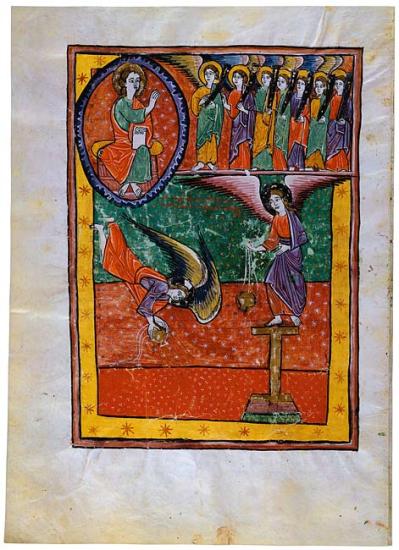
Appearance Of The Seven Angels With Trumpets
Beatus of Liébana
Las Huelgas Apocalypse
Purchased by Pierpont Morgan, 1910
And I saw seven angels standing in the sight of God. And seven trumpets were given to them. And another angel approached and stood before the altar, holding a golden censer. And much incense was given to him, so he might offer upon the golden altar before God's throne the prayers of all the saints. And the smoke of the incense of the prayers of the saints ascended, in the presence of God, from the hand of the angel. And the angel received the golden censer, filled it from the fire of the altar, and cast it down upon the earth, and there were thunders and voices and lightnings and a great earthquake. (Rev. 8:2–5)
This full-page miniature marks the beginning of seven miniatures depicting the events following the sounding of the trumpets. The angel standing on the gold altar seems to have already spilled the contents of his censer. Fire arrows fall on the earth from the censer held by the descending angel.
The Apocalypse, or Book of Revelation, is not only the last Book of the New Testament, but its most difficult, puzzling, and terrifying. It provided challenges to medieval illustrators and was the source for a number of popular images, such as Christ in Majesty, the Adoration of the Lamb, and the Madonna of the Apocalypse and contributed to the widespread use of the Evangelists' symbols.
Selected images from Apocalypse Then: Medieval Illuminations from the Morgan, an exhibition held at the Morgan are presented here. The exhibition celebrates the completion of a facsimile of the Morgan's Las Huelgas Apocalypse—the latest dated (1220) and largest surviving manuscript of a Spanish tradition of illuminated commentaries on the Apocalypse by the monk Beatus of Liébana. The series of manuscripts constitutes Spain's most important contribution to medieval manuscript illumination.
The Las Huelgas Apocalypse contains three sections: the prefatory cycle, the Apocalypse, and the Book of Daniel.
In addition to forty-nine images from the Las Huelgas Apocalypse, six images from other manuscripts in the Morgan's collections, including the earliest Beatus painted by Maius and one by the Master of the Berry Apocalypse, are in this presentation.
Fol. 89
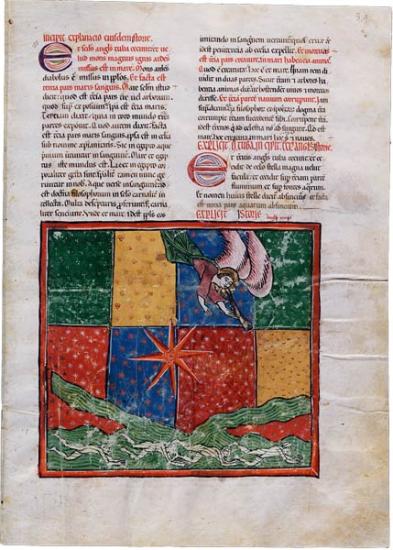
Third Trumpet: Flaming Star Falls in the River
Beatus of Liébana
Las Huelgas Apocalypse
Purchased by Pierpont Morgan, 1910
And the third angel sounded the trumpet. And a great star fell from heaven, burning like a torch. And it fell upon a third part of the rivers and upon the sources of water. And the name of the star is called Wormwood. And a third part of the waters were turned into wormwood. And many men died from the waters, because they were made bitter. (Rev. 8:10–11)
The giant burning star is red, but not torchlike as in some Beatus manuscripts. The two green diagonal strips suggest rivers. The four floating, naked dead men, poisoned by the bitter waters, make their first appearance in the earliest surviving Beatus, the Morgan's mid-tenth-century manuscript illuminated by Maius.
The Apocalypse, or Book of Revelation, is not only the last Book of the New Testament, but its most difficult, puzzling, and terrifying. It provided challenges to medieval illustrators and was the source for a number of popular images, such as Christ in Majesty, the Adoration of the Lamb, and the Madonna of the Apocalypse and contributed to the widespread use of the Evangelists' symbols.
Selected images from Apocalypse Then: Medieval Illuminations from the Morgan, an exhibition held at the Morgan are presented here. The exhibition celebrates the completion of a facsimile of the Morgan's Las Huelgas Apocalypse—the latest dated (1220) and largest surviving manuscript of a Spanish tradition of illuminated commentaries on the Apocalypse by the monk Beatus of Liébana. The series of manuscripts constitutes Spain's most important contribution to medieval manuscript illumination.
The Las Huelgas Apocalypse contains three sections: the prefatory cycle, the Apocalypse, and the Book of Daniel.
In addition to forty-nine images from the Las Huelgas Apocalypse, six images from other manuscripts in the Morgan's collections, including the earliest Beatus painted by Maius and one by the Master of the Berry Apocalypse, are in this presentation.
Fol. 90v
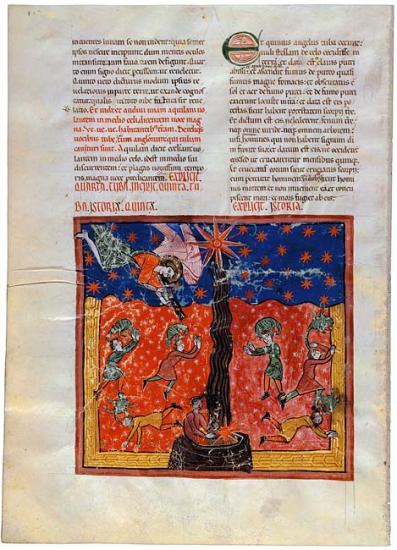
Fifth Trumpet: The Star Falling Into The Bottomless Pit And The Plague Of Locusts
Beatus of Liébana
Las Huelgas Apocalypse
Purchased by Pierpont Morgan, 1910
And the fifth angel sounded the trumpet. And I saw upon the earth a star that had fallen from heaven, and the key to the well of the abyss was given to him. And he opened the well of the abyss. And the smoke of the well ascended, like the smoke of a great furnace. And the sun and the air were obscured by the smoke of the well. And locusts went forth from the smoke of the well into the earth. And power was given to them, like the power that the scorpions of the earth have. And it was commanded that they must not harm the plants of the earth, nor anything green, nor any tree, but only those men who do not have the Seal of God upon their foreheads. And they were not to kill them, but torture them for five months. In those days, men will seek death but not find it; they will desire to die, and death will flee from them. (Rev. 9:1–6)
The artist depicted the falling star twice, in the sky and in the pit. According to Beatus, the man in the pit with the key and the star relate to fallen sinners who have opened their hearts to Satan.
The Apocalypse, or Book of Revelation, is not only the last Book of the New Testament, but its most difficult, puzzling, and terrifying. It provided challenges to medieval illustrators and was the source for a number of popular images, such as Christ in Majesty, the Adoration of the Lamb, and the Madonna of the Apocalypse and contributed to the widespread use of the Evangelists' symbols.
Selected images from Apocalypse Then: Medieval Illuminations from the Morgan, an exhibition held at the Morgan are presented here. The exhibition celebrates the completion of a facsimile of the Morgan's Las Huelgas Apocalypse—the latest dated (1220) and largest surviving manuscript of a Spanish tradition of illuminated commentaries on the Apocalypse by the monk Beatus of Liébana. The series of manuscripts constitutes Spain's most important contribution to medieval manuscript illumination.
The Las Huelgas Apocalypse contains three sections: the prefatory cycle, the Apocalypse, and the Book of Daniel.
In addition to forty-nine images from the Las Huelgas Apocalypse, six images from other manuscripts in the Morgan's collections, including the earliest Beatus painted by Maius and one by the Master of the Berry Apocalypse, are in this presentation.
Fol. 94
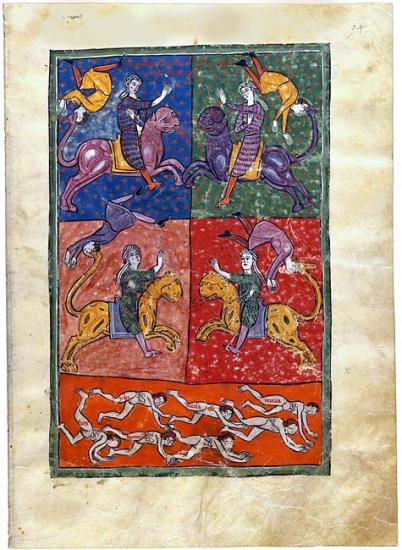
Sixth Trumpet: The Army Of Horsemen Over Lion-Headed Horses
Beatus of Liébana
Las Huelgas Apocalypse
Purchased by Pierpont Morgan, 1910
And I saw the horses in the vision. And the horsemen had breastplates of fire, hyacinth, and sulfur. And the heads of the horses were like the heads of lions. And from their mouths came fire, smoke, and sulfur. And one-third part of men was slain by these three afflictions. For the power of these horses is in their mouths and tails. Their tails resemble serpents, and it is the heads that cause harm. And the men who were not slain by these afflictions did not repent from the works of their hands, from worshiping demons or idols, or from their murders, drugs, fornications, and thefts. (Rev. 9:17–21)
This miniature supplies the horsemen with turbans, which usually designate Muslims or Moors. For Beatus, however, the horsemen represent false Christians and demon spirits. The naked corpses at bottom represent the one-third of humanity slain.
The Apocalypse, or Book of Revelation, is not only the last Book of the New Testament, but its most difficult, puzzling, and terrifying. It provided challenges to medieval illustrators and was the source for a number of popular images, such as Christ in Majesty, the Adoration of the Lamb, and the Madonna of the Apocalypse and contributed to the widespread use of the Evangelists' symbols.
Selected images from Apocalypse Then: Medieval Illuminations from the Morgan, an exhibition held at the Morgan are presented here. The exhibition celebrates the completion of a facsimile of the Morgan's Las Huelgas Apocalypse—the latest dated (1220) and largest surviving manuscript of a Spanish tradition of illuminated commentaries on the Apocalypse by the monk Beatus of Liébana. The series of manuscripts constitutes Spain's most important contribution to medieval manuscript illumination.
The Las Huelgas Apocalypse contains three sections: the prefatory cycle, the Apocalypse, and the Book of Daniel.
In addition to forty-nine images from the Las Huelgas Apocalypse, six images from other manuscripts in the Morgan's collections, including the earliest Beatus painted by Maius and one by the Master of the Berry Apocalypse, are in this presentation.
Fols. 95v-96
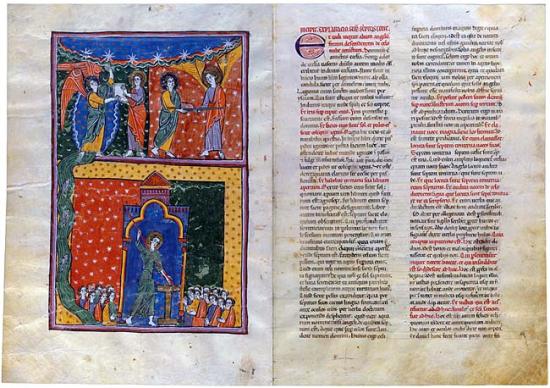
John Receives The Book And The Rod And Measures The Temple
Beatus of Liébana
Las Huelgas Apocalypse
Purchased by Pierpont Morgan, 1910
And I saw another strong angel, descending from heaven, clothed with a cloud. And a rainbow was upon his head, and his face was like the sun, and his feet were like columns of fire. He held in his hand a small open book, stationed his right foot on the sea, and his left foot on the land. And the angel said: "Receive the book and consume it. And it shall cause bitterness in your stomach, but in your mouth it shall be sweet like honey." And a reedlike staff was given to me. And I was told: "Rise up and measure the temple of God, the worshipers, and the altar. But do not measure the atrium outside of the temple because it has been given over to the Gentiles. And they shall trample upon the Holy City for forty-two months. (Rev. 10:1–11:2)
The angel, "clothed" with a band of star-filled clouds, stands on a stream with fish extending to the bottom of the page. At the bottom John measures the gold altar and the group of worshipers on the right. The unconcerned group on the left refers to the Gentiles. The rubric at the top of the facing page (Incipit explanacio) marks the beginning of the commentary.
The Apocalypse, or Book of Revelation, is not only the last Book of the New Testament, but its most difficult, puzzling, and terrifying. It provided challenges to medieval illustrators and was the source for a number of popular images, such as Christ in Majesty, the Adoration of the Lamb, and the Madonna of the Apocalypse and contributed to the widespread use of the Evangelists' symbols.
Selected images from Apocalypse Then: Medieval Illuminations from the Morgan, an exhibition held at the Morgan are presented here. The exhibition celebrates the completion of a facsimile of the Morgan's Las Huelgas Apocalypse—the latest dated (1220) and largest surviving manuscript of a Spanish tradition of illuminated commentaries on the Apocalypse by the monk Beatus of Liébana. The series of manuscripts constitutes Spain's most important contribution to medieval manuscript illumination.
The Las Huelgas Apocalypse contains three sections: the prefatory cycle, the Apocalypse, and the Book of Daniel.
In addition to forty-nine images from the Las Huelgas Apocalypse, six images from other manuscripts in the Morgan's collections, including the earliest Beatus painted by Maius and one by the Master of the Berry Apocalypse, are in this presentation.
Fols. 101v-102
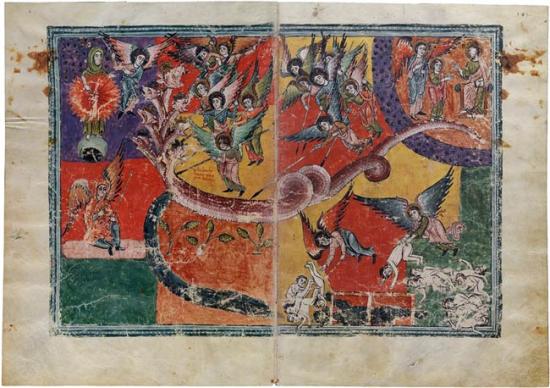
Woman Clothed in the Sun and the Defeat of the Seven-Headed Dragon
Beatus of Liébana
Las Huelgas Apocalypse
Purchased by Pierpont Morgan, 1910
And a great sign appeared in heaven: a woman clothed with the sun, and the moon was under her feet, and on her head was a crown of twelve stars. And being with child, she cried out while giving birth. And another sign was seen in heaven: a great red dragon, having seven heads and ten horns, and on his heads were seven diadems. And his tail drew down a third part of the stars of heaven and cast them to the earth. And the dragon stood before the woman, who was about to give birth, so that, when she had brought forth, he might devour her son. And she brought forth a male child, who was soon to rule all the nations with an iron rod. And her son was taken up to God and to his throne. And Michael and his angels were battling with the dragon, and the dragon was fighting, and so were his angels. But they did not prevail, and that great dragon, the ancient serpent called the devil and Satan, was thrown down to the earth, and his angels were cast down with him. And I heard a great voice in heaven, saying: "Now have arrived salvation and virtue and the kingdom of our God and the power of his Christ." And the dragon pursued the woman (who received eagle wings to escape into the desert), sending out of his mouth water, like a river, so that she might be carried away. But the earth assisted the woman and absorbed the river.
(Rev. 12:1–17)
Although later exegetes equated the Madonna of the Apocalypse with the Virgin Mary, Beatus saw her as the Church that, through baptism and sermons, gives daily birth to Christ among believers. The woman is shown twice, at upper left, clothed with the sun, and below (with wings), after her escape to the desert, where she avoided the river issuing from the dragon. At upper right, her son (Christ) stands before God. At lower right angels condemn naked sinners to hell, where Satan is already imprisoned.
The Apocalypse, or Book of Revelation, is not only the last Book of the New Testament, but its most difficult, puzzling, and terrifying. It provided challenges to medieval illustrators and was the source for a number of popular images, such as Christ in Majesty, the Adoration of the Lamb, and the Madonna of the Apocalypse and contributed to the widespread use of the Evangelists' symbols.
Selected images from Apocalypse Then: Medieval Illuminations from the Morgan, an exhibition held at the Morgan are presented here. The exhibition celebrates the completion of a facsimile of the Morgan's Las Huelgas Apocalypse—the latest dated (1220) and largest surviving manuscript of a Spanish tradition of illuminated commentaries on the Apocalypse by the monk Beatus of Liébana. The series of manuscripts constitutes Spain's most important contribution to medieval manuscript illumination.
The Las Huelgas Apocalypse contains three sections: the prefatory cycle, the Apocalypse, and the Book of Daniel.
In addition to forty-nine images from the Las Huelgas Apocalypse, six images from other manuscripts in the Morgan's collections, including the earliest Beatus painted by Maius and one by the Master of the Berry Apocalypse, are in this presentation.
Fol. 113v
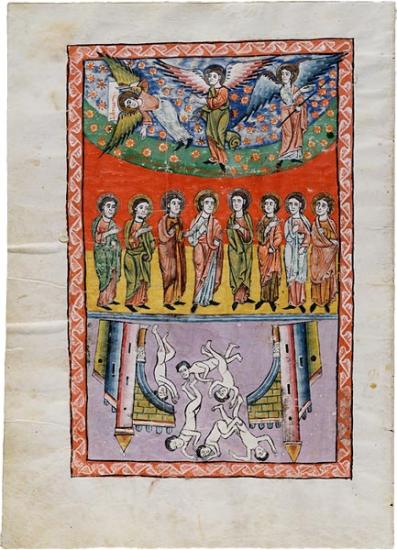
Angel Of The Eternal Gospel, Worshipers, And The Fall Of Babylon
Beatus of Liébana
Las Huelgas Apocalypse
Purchased by Pierpont Morgan, 1910
And I saw another angel, flying through the midst of heaven, holding the eternal Gospel, so as to evangelize those sitting upon the earth and those of every nation and tribe and language and people, saying: "Fear the Lord, and give honor to him, for the hour of his judgment has arrived." And another angel followed, saying: "Fallen, fallen is Babylon the great, who inebriated all nations with the wine of her wrath and fornication." And the third angel followed them, saying: "If anyone has worshiped the beast, or his image, or has received his character on his forehead or on his hand, he shall drink also from the wine of the wrath of God, and be tortured with fire and sulfur in the sight of the holy angels and before the sight of the Lamb." (Rev. 14:6–10)
All three angels appear at the top. The one with the eternal Gospel points to a scroll inscribed Librum (Book) and to the haloed figures below who obeyed his words. At bottom is the fall of Babylon, where corpses, some with open eyes, fall through the upside-down broken gate to the city.
The Apocalypse, or Book of Revelation, is not only the last Book of the New Testament, but its most difficult, puzzling, and terrifying. It provided challenges to medieval illustrators and was the source for a number of popular images, such as Christ in Majesty, the Adoration of the Lamb, and the Madonna of the Apocalypse and contributed to the widespread use of the Evangelists' symbols.
Selected images from Apocalypse Then: Medieval Illuminations from the Morgan, an exhibition held at the Morgan are presented here. The exhibition celebrates the completion of a facsimile of the Morgan's Las Huelgas Apocalypse—the latest dated (1220) and largest surviving manuscript of a Spanish tradition of illuminated commentaries on the Apocalypse by the monk Beatus of Liébana. The series of manuscripts constitutes Spain's most important contribution to medieval manuscript illumination.
The Las Huelgas Apocalypse contains three sections: the prefatory cycle, the Apocalypse, and the Book of Daniel.
In addition to forty-nine images from the Las Huelgas Apocalypse, six images from other manuscripts in the Morgan's collections, including the earliest Beatus painted by Maius and one by the Master of the Berry Apocalypse, are in this presentation.
Fol. 116v
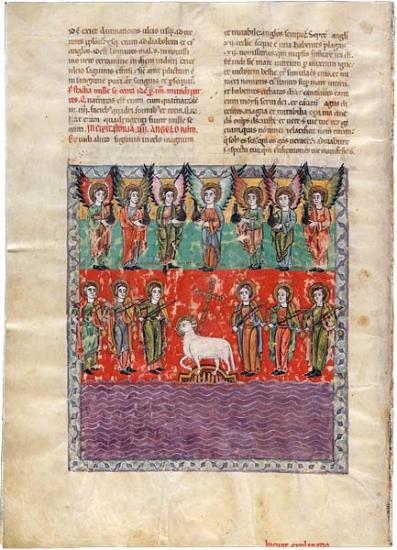
Seven Angels of the Seven Plagues and the Song of the Lamb
Beatus of Liébana
Las Huelgas Apocalypse
Purchased by Pierpont Morgan, 1910
And I saw another sign in heaven, great and wondrous: seven angels holding the seven last afflictions. For with them, the wrath of God is completed. And I saw something like a sea of glass mixed with fire. And those who had overcome the beast and his image and the number of his name, were standing upon the sea of glass, holding the harps of God, and singing the canticle of Moses and the canticle of the Lamb, saying: "Great and wondrous are your works, Lord God Almighty. Just and true are your ways, King of all ages." (Rev. 15:1–3)
According to the commentary, the seven angels are the seven churches of Asia, who will empty their cups (shown as flasks) on the blind so that they might see the truth. In the second register the successful believers praise the Lamb (here holding a cross), but with bow instruments rather than harps. The wavy purple band at bottom represents the sea of glass.
The Apocalypse, or Book of Revelation, is not only the last Book of the New Testament, but its most difficult, puzzling, and terrifying. It provided challenges to medieval illustrators and was the source for a number of popular images, such as Christ in Majesty, the Adoration of the Lamb, and the Madonna of the Apocalypse and contributed to the widespread use of the Evangelists' symbols.
Selected images from Apocalypse Then: Medieval Illuminations from the Morgan, an exhibition held at the Morgan are presented here. The exhibition celebrates the completion of a facsimile of the Morgan's Las Huelgas Apocalypse—the latest dated (1220) and largest surviving manuscript of a Spanish tradition of illuminated commentaries on the Apocalypse by the monk Beatus of Liébana. The series of manuscripts constitutes Spain's most important contribution to medieval manuscript illumination.
The Las Huelgas Apocalypse contains three sections: the prefatory cycle, the Apocalypse, and the Book of Daniel.
In addition to forty-nine images from the Las Huelgas Apocalypse, six images from other manuscripts in the Morgan's collections, including the earliest Beatus painted by Maius and one by the Master of the Berry Apocalypse, are in this presentation.
Fol. 118
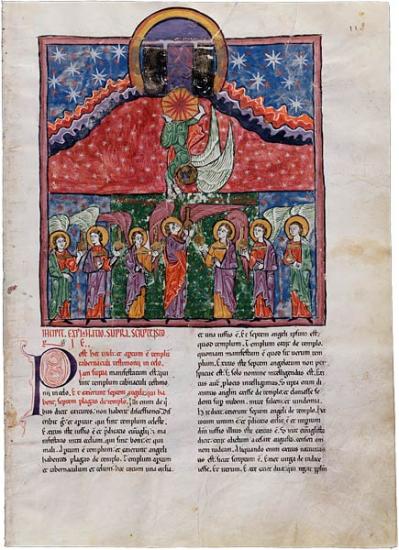
Seven Plague Angels Before the Open Temple of Heaven
Beatus of Liébana
Las Huelgas Apocalypse
Purchased by Pierpont Morgan, 1910
I saw that the temple of the tabernacle of the testimony in heaven was opened. And the seven angels went forth from the temple, holding the seven afflictions, clothed with clean white linen, and girded around the chest with wide golden belts. And one of the four living creatures gave to the seven angels seven golden bowls, filled with the wrath of God. And the temple was filled with smoke from the majesty of God and from his power, and no one could enter in until the seven afflictions of the seven angels were completed. (Rev. 15:5–8)
The illuminator chose the eagle—the symbol of John—as the living creature to issue forth from the smoke-filled temple at the top. While the angels are not in white linen, their chests are girded in gold.
The Apocalypse, or Book of Revelation, is not only the last Book of the New Testament, but its most difficult, puzzling, and terrifying. It provided challenges to medieval illustrators and was the source for a number of popular images, such as Christ in Majesty, the Adoration of the Lamb, and the Madonna of the Apocalypse and contributed to the widespread use of the Evangelists' symbols.
Selected images from Apocalypse Then: Medieval Illuminations from the Morgan, an exhibition held at the Morgan are presented here. The exhibition celebrates the completion of a facsimile of the Morgan's Las Huelgas Apocalypse—the latest dated (1220) and largest surviving manuscript of a Spanish tradition of illuminated commentaries on the Apocalypse by the monk Beatus of Liébana. The series of manuscripts constitutes Spain's most important contribution to medieval manuscript illumination.
The Las Huelgas Apocalypse contains three sections: the prefatory cycle, the Apocalypse, and the Book of Daniel.
In addition to forty-nine images from the Las Huelgas Apocalypse, six images from other manuscripts in the Morgan's collections, including the earliest Beatus painted by Maius and one by the Master of the Berry Apocalypse, are in this presentation.
Fol. 121v
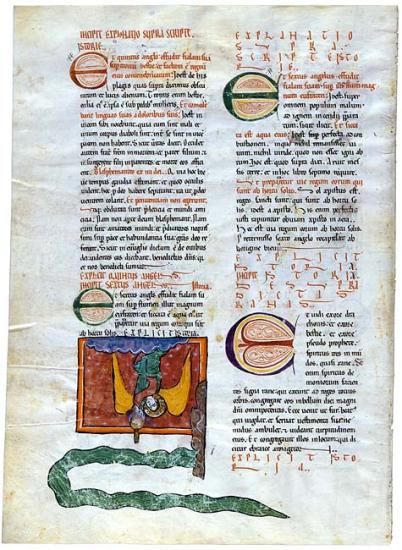
Sixth Angel Empties His Bowl On The Euphrates
Beatus of Liébana
Las Huelgas Apocalypse
Purchased by Pierpont Morgan, 1910
And the sixth angel poured out his bowl upon the great river Euphrates. And its water dried up so that a way might be prepared for the kings from the rising of the sun. (Rev. 16:12)
Evidently insufficient space was left for the miniature, so the Euphrates flows from the vertical brown earth into the margin and in the direction of the large miniature on the opposite page (exhibited at the right), which continues the story. According to the commentary, the kings are saints who will be taken away by Christ.
The Apocalypse, or Book of Revelation, is not only the last Book of the New Testament, but its most difficult, puzzling, and terrifying. It provided challenges to medieval illustrators and was the source for a number of popular images, such as Christ in Majesty, the Adoration of the Lamb, and the Madonna of the Apocalypse and contributed to the widespread use of the Evangelists' symbols.
Selected images from Apocalypse Then: Medieval Illuminations from the Morgan, an exhibition held at the Morgan are presented here. The exhibition celebrates the completion of a facsimile of the Morgan's Las Huelgas Apocalypse—the latest dated (1220) and largest surviving manuscript of a Spanish tradition of illuminated commentaries on the Apocalypse by the monk Beatus of Liébana. The series of manuscripts constitutes Spain's most important contribution to medieval manuscript illumination.
The Las Huelgas Apocalypse contains three sections: the prefatory cycle, the Apocalypse, and the Book of Daniel.
In addition to forty-nine images from the Las Huelgas Apocalypse, six images from other manuscripts in the Morgan's collections, including the earliest Beatus painted by Maius and one by the Master of the Berry Apocalypse, are in this presentation.
Fol. 122
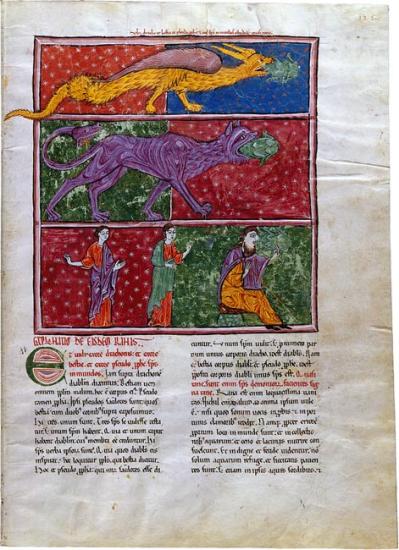
Froglike Spirits
Beatus of Liébana
Las Huelgas Apocalypse
Purchased by Pierpont Morgan, 1910
And I saw, from the mouth of the dragon, and from the mouth of the beast, and from the mouth of the false prophet, three unclean spirits go out in the manner of frogs. For these are the spirits of the demons that were causing the signs. And they advance to the kings of the entire earth, to gather them for battle on the great day of Almighty God. "Behold, I arrive like a thief. Blessed is he who is vigilant and who preserves his vestment, lest he walk naked and they see his disgrace." And he shall gather them together at a place which is called, in Hebrew, Armageddon. (Rev. 16:13–16)
According to Beatus, even though the dragon and the beast represent the devil, and the false prophet symbolizes false priests, they all make up the body of Satan. It has been suggested that the features of the false prophet represent him as a Jew; to his left are two of his followers.
The Apocalypse, or Book of Revelation, is not only the last Book of the New Testament, but its most difficult, puzzling, and terrifying. It provided challenges to medieval illustrators and was the source for a number of popular images, such as Christ in Majesty, the Adoration of the Lamb, and the Madonna of the Apocalypse and contributed to the widespread use of the Evangelists' symbols.
Selected images from Apocalypse Then: Medieval Illuminations from the Morgan, an exhibition held at the Morgan are presented here. The exhibition celebrates the completion of a facsimile of the Morgan's Las Huelgas Apocalypse—the latest dated (1220) and largest surviving manuscript of a Spanish tradition of illuminated commentaries on the Apocalypse by the monk Beatus of Liébana. The series of manuscripts constitutes Spain's most important contribution to medieval manuscript illumination.
The Las Huelgas Apocalypse contains three sections: the prefatory cycle, the Apocalypse, and the Book of Daniel.
In addition to forty-nine images from the Las Huelgas Apocalypse, six images from other manuscripts in the Morgan's collections, including the earliest Beatus painted by Maius and one by the Master of the Berry Apocalypse, are in this presentation.
Fol. 124v
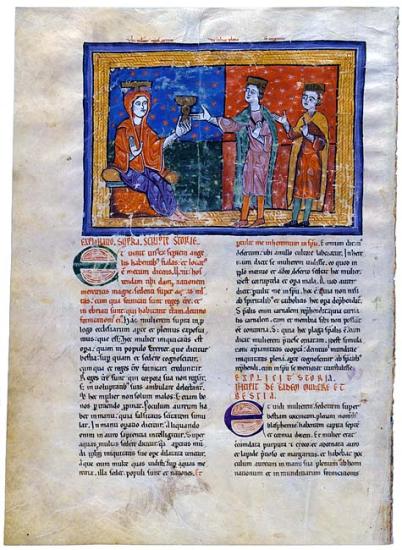
Whore Of Babylon And The Kings
Beatus of Liébana
Las Huelgas Apocalypse
Purchased by Pierpont Morgan, 1910
And one of the seven angels who held the seven bowls approached and spoke with me, saying: "Come, I will show you the condemnation of the great harlot, who sits upon many waters. With her, the kings of the earth have fornicated. And those who inhabit the earth have been inebriated by the wine of her prostitution." (Rev. 17:1–2)
Babylon is a metaphor for the sin city of its day, which has made the kings fall into vice. The whore's cup contains the abominations and impurities of her fornication; she hands the cup to a king who fingers the cord of his garment with the gesture of a courtesan.
The Apocalypse, or Book of Revelation, is not only the last Book of the New Testament, but its most difficult, puzzling, and terrifying. It provided challenges to medieval illustrators and was the source for a number of popular images, such as Christ in Majesty, the Adoration of the Lamb, and the Madonna of the Apocalypse and contributed to the widespread use of the Evangelists' symbols.
Selected images from Apocalypse Then: Medieval Illuminations from the Morgan, an exhibition held at the Morgan are presented here. The exhibition celebrates the completion of a facsimile of the Morgan's Las Huelgas Apocalypse—the latest dated (1220) and largest surviving manuscript of a Spanish tradition of illuminated commentaries on the Apocalypse by the monk Beatus of Liébana. The series of manuscripts constitutes Spain's most important contribution to medieval manuscript illumination.
The Las Huelgas Apocalypse contains three sections: the prefatory cycle, the Apocalypse, and the Book of Daniel.
In addition to forty-nine images from the Las Huelgas Apocalypse, six images from other manuscripts in the Morgan's collections, including the earliest Beatus painted by Maius and one by the Master of the Berry Apocalypse, are in this presentation.
Fol. 125
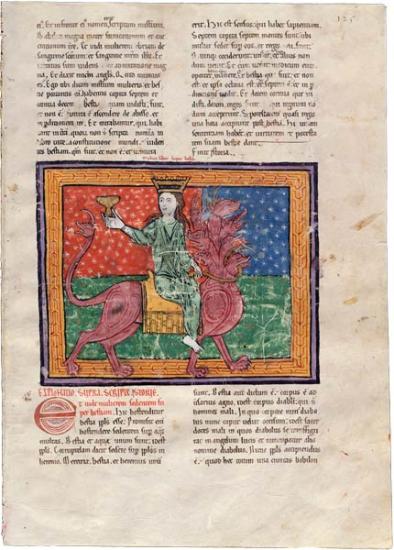
Whore of Babylon on the Seven-Headed Beast
Beatus of Liébana
Las Huelgas Apocalypse
Purchased by Pierpont Morgan, 1910
I saw a woman sitting upon a scarlet beast, filled with names of blasphemy, having seven heads and ten horns. And the woman was clothed all around with purple and scarlet, and adorned with gold and precious stones and pearls, holding a golden cup in her hand, filled with the abomination and the filth of her fornication. And on her forehead was written: Mystery, Babylon the great. The beast that you saw was, and is not, and is soon to ascend from the abyss and go forth unto destruction. (Rev. 17:3–8)
The whore, sitting on a scarlet beast, wears a Moorish crown; her long, loose hair suggests her licentiousness.
The Apocalypse, or Book of Revelation, is not only the last Book of the New Testament, but its most difficult, puzzling, and terrifying. It provided challenges to medieval illustrators and was the source for a number of popular images, such as Christ in Majesty, the Adoration of the Lamb, and the Madonna of the Apocalypse and contributed to the widespread use of the Evangelists' symbols.
Selected images from Apocalypse Then: Medieval Illuminations from the Morgan, an exhibition held at the Morgan are presented here. The exhibition celebrates the completion of a facsimile of the Morgan's Las Huelgas Apocalypse—the latest dated (1220) and largest surviving manuscript of a Spanish tradition of illuminated commentaries on the Apocalypse by the monk Beatus of Liébana. The series of manuscripts constitutes Spain's most important contribution to medieval manuscript illumination.
The Las Huelgas Apocalypse contains three sections: the prefatory cycle, the Apocalypse, and the Book of Daniel.
In addition to forty-nine images from the Las Huelgas Apocalypse, six images from other manuscripts in the Morgan's collections, including the earliest Beatus painted by Maius and one by the Master of the Berry Apocalypse, are in this presentation.
Fol. 131v
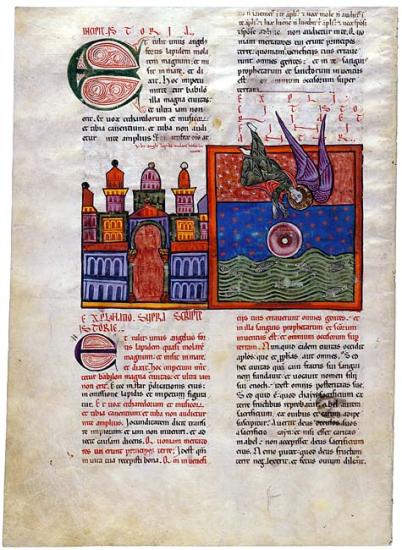
Angel Of The Millstone
Beatus of Liébana
Las Huelgas Apocalypse
Purchased by Pierpont Morgan, 1910
A certain strong angel took up a stone, similar to a great millstone, and cast it into the sea, saying: "With this force shall Babylon, that great city, be cast down. And she shall never be found again. And the sound of singers, and musicians, and flute and trumpet players shall not be heard in you again. And every artisan of every art shall not be found in you again. And the sound of the mill shall not be heard in you again." (Rev. 18:21–22)
Babylon is shown on the left, while the millstone, a metaphor for the city, is hurled into a fish-filled sea by an angel.
The Apocalypse, or Book of Revelation, is not only the last Book of the New Testament, but its most difficult, puzzling, and terrifying. It provided challenges to medieval illustrators and was the source for a number of popular images, such as Christ in Majesty, the Adoration of the Lamb, and the Madonna of the Apocalypse and contributed to the widespread use of the Evangelists' symbols.
Selected images from Apocalypse Then: Medieval Illuminations from the Morgan, an exhibition held at the Morgan are presented here. The exhibition celebrates the completion of a facsimile of the Morgan's Las Huelgas Apocalypse—the latest dated (1220) and largest surviving manuscript of a Spanish tradition of illuminated commentaries on the Apocalypse by the monk Beatus of Liébana. The series of manuscripts constitutes Spain's most important contribution to medieval manuscript illumination.
The Las Huelgas Apocalypse contains three sections: the prefatory cycle, the Apocalypse, and the Book of Daniel.
In addition to forty-nine images from the Las Huelgas Apocalypse, six images from other manuscripts in the Morgan's collections, including the earliest Beatus painted by Maius and one by the Master of the Berry Apocalypse, are in this presentation.
Fol. 134v
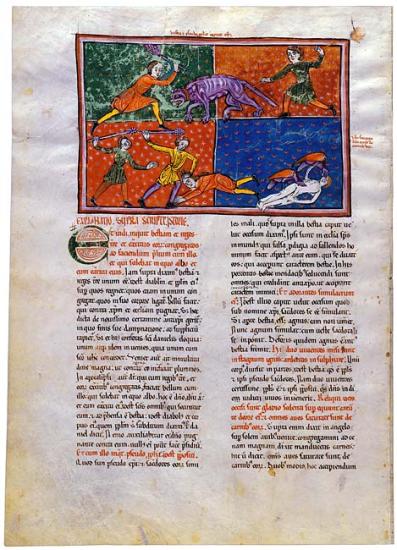
Capture Of The Beast And Of The False Prophet
Beatus of Liébana
Las Huelgas Apocalypse
Purchased by Pierpont Morgan, 1910
I saw the beast and the kings of the earth and their armies, having been gathered together to do battle against him who was sitting upon the horse, and against his army. And the beast was apprehended, and with him the false prophet, who in his presence caused the signs by which were seduced those who accepted the character of the beast and who worshiped his image. These two were cast alive into the pool of fire burning with sulfur. And the others were slain by the sword that proceeds from the mouth of him who was sitting upon the horse. And all the birds were sated with their flesh. (Rev. 19:19–21)
The beast is slain and the false prophet beaten by men wielding maces. At right two birds feast on the flesh of a follower of the false prophet.
The Apocalypse, or Book of Revelation, is not only the last Book of the New Testament, but its most difficult, puzzling, and terrifying. It provided challenges to medieval illustrators and was the source for a number of popular images, such as Christ in Majesty, the Adoration of the Lamb, and the Madonna of the Apocalypse and contributed to the widespread use of the Evangelists' symbols.
Selected images from Apocalypse Then: Medieval Illuminations from the Morgan, an exhibition held at the Morgan are presented here. The exhibition celebrates the completion of a facsimile of the Morgan's Las Huelgas Apocalypse—the latest dated (1220) and largest surviving manuscript of a Spanish tradition of illuminated commentaries on the Apocalypse by the monk Beatus of Liébana. The series of manuscripts constitutes Spain's most important contribution to medieval manuscript illumination.
The Las Huelgas Apocalypse contains three sections: the prefatory cycle, the Apocalypse, and the Book of Daniel.
In addition to forty-nine images from the Las Huelgas Apocalypse, six images from other manuscripts in the Morgan's collections, including the earliest Beatus painted by Maius and one by the Master of the Berry Apocalypse, are in this presentation.
Fol. 135
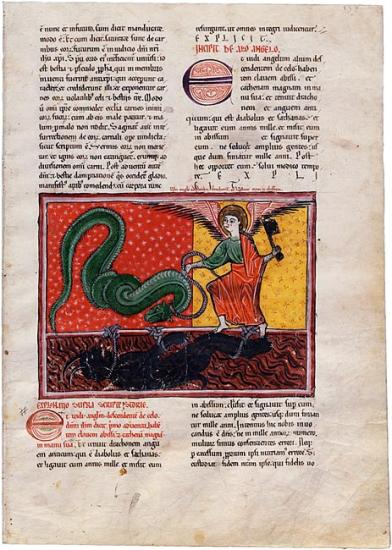
Devil Chained in the Abyss and the Dragon
Beatus of Liébana
Las Huelgas Apocalypse
Purchased by Pierpont Morgan, 1910
I saw an angel, descending from heaven, holding in his hand the key of the abyss and a great chain. And he apprehended the dragon, the ancient serpent, who is the devil and Satan, and he bound him for a thousand years. And he cast him into the abyss, and he closed and sealed it, so that he would no longer seduce the nations, until the thousand years are completed. And after these things, he must be released for a brief time. (Rev. 20:1–3)
For Beatus the angel is a symbol of Christ, who expels Satan from the hearts of believers with his incarnation and crucifixion.
The Apocalypse, or Book of Revelation, is not only the last Book of the New Testament, but its most difficult, puzzling, and terrifying. It provided challenges to medieval illustrators and was the source for a number of popular images, such as Christ in Majesty, the Adoration of the Lamb, and the Madonna of the Apocalypse and contributed to the widespread use of the Evangelists' symbols.
Selected images from Apocalypse Then: Medieval Illuminations from the Morgan, an exhibition held at the Morgan are presented here. The exhibition celebrates the completion of a facsimile of the Morgan's Las Huelgas Apocalypse—the latest dated (1220) and largest surviving manuscript of a Spanish tradition of illuminated commentaries on the Apocalypse by the monk Beatus of Liébana. The series of manuscripts constitutes Spain's most important contribution to medieval manuscript illumination.
The Las Huelgas Apocalypse contains three sections: the prefatory cycle, the Apocalypse, and the Book of Daniel.
In addition to forty-nine images from the Las Huelgas Apocalypse, six images from other manuscripts in the Morgan's collections, including the earliest Beatus painted by Maius and one by the Master of the Berry Apocalypse, are in this presentation.
Fol. 137
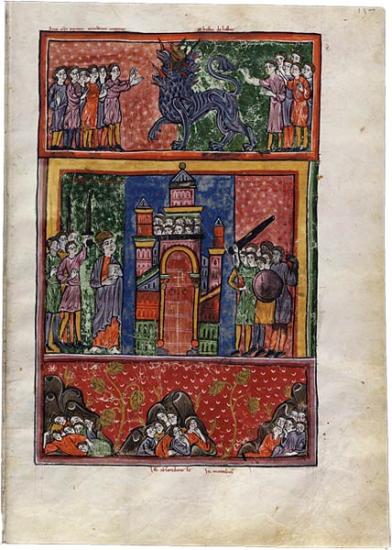
Satan's Last Attack: Gog and Magog
Beatus of Liébana
Las Huelgas Apocalypse
Purchased by Pierpont Morgan, 1910
And when the thousand years will have been completed, Satan shall be released from his prison, and he shall go out and seduce the nations which are upon the four quarters of the earth, Gog and Magog. And he shall gather them together for battle, those whose number is like the sand of the sea. And they climbed across the breadth of the earth, and they encompassed the camp of the saints and the beloved city. (Rev. 20:7–9)
The beast and his followers are at top. Below is the beloved city (symbol of the Church), besieged by attackers led by a tall figure with a book—the Antichrist. At bottom, the believers seek refuge in the mountains (based on Matt. 22:16).
The Apocalypse, or Book of Revelation, is not only the last Book of the New Testament, but its most difficult, puzzling, and terrifying. It provided challenges to medieval illustrators and was the source for a number of popular images, such as Christ in Majesty, the Adoration of the Lamb, and the Madonna of the Apocalypse and contributed to the widespread use of the Evangelists' symbols.
Selected images from Apocalypse Then: Medieval Illuminations from the Morgan, an exhibition held at the Morgan are presented here. The exhibition celebrates the completion of a facsimile of the Morgan's Las Huelgas Apocalypse—the latest dated (1220) and largest surviving manuscript of a Spanish tradition of illuminated commentaries on the Apocalypse by the monk Beatus of Liébana. The series of manuscripts constitutes Spain's most important contribution to medieval manuscript illumination.
The Las Huelgas Apocalypse contains three sections: the prefatory cycle, the Apocalypse, and the Book of Daniel.
In addition to forty-nine images from the Las Huelgas Apocalypse, six images from other manuscripts in the Morgan's collections, including the earliest Beatus painted by Maius and one by the Master of the Berry Apocalypse, are in this presentation.
Fol. 138v
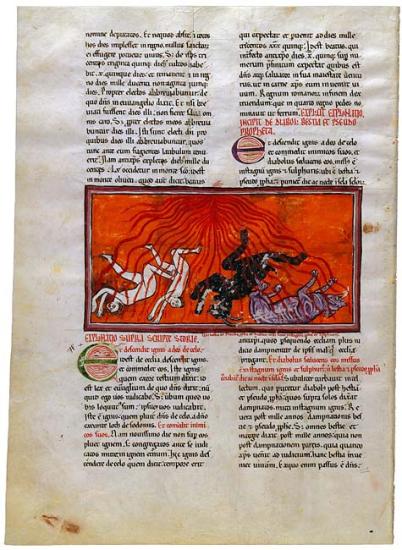
Satan, The Beast, And The False Prophet In The Lake Of Fire
Beatus of Liébana
Las Huelgas Apocalypse
Purchased by Pierpont Morgan, 1910
The devil, who seduced them, was cast into the pool of fire and sulfur, where both the beast and the false prophet shall be tortured, day and night, forever and ever. (Rev. 20:9–10)
After the defeat of the Antichrist, Satan, the beast, and the false prophet suffer in the lake of fire. The second prophet was perhaps added to achieve symmetry.
The Apocalypse, or Book of Revelation, is not only the last Book of the New Testament, but its most difficult, puzzling, and terrifying. It provided challenges to medieval illustrators and was the source for a number of popular images, such as Christ in Majesty, the Adoration of the Lamb, and the Madonna of the Apocalypse and contributed to the widespread use of the Evangelists' symbols.
Selected images from Apocalypse Then: Medieval Illuminations from the Morgan, an exhibition held at the Morgan are presented here. The exhibition celebrates the completion of a facsimile of the Morgan's Las Huelgas Apocalypse—the latest dated (1220) and largest surviving manuscript of a Spanish tradition of illuminated commentaries on the Apocalypse by the monk Beatus of Liébana. The series of manuscripts constitutes Spain's most important contribution to medieval manuscript illumination.
The Las Huelgas Apocalypse contains three sections: the prefatory cycle, the Apocalypse, and the Book of Daniel.
In addition to forty-nine images from the Las Huelgas Apocalypse, six images from other manuscripts in the Morgan's collections, including the earliest Beatus painted by Maius and one by the Master of the Berry Apocalypse, are in this presentation.
Fol. 140v
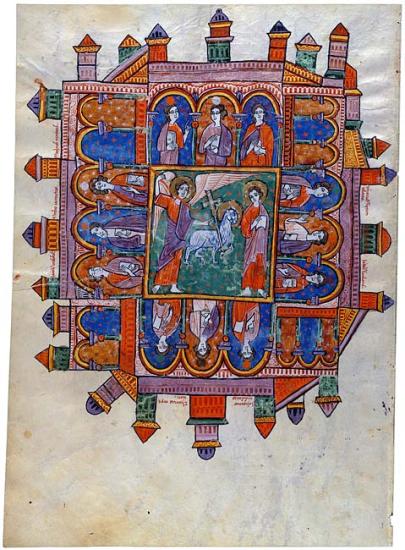
Heavenly Jerusalem
Beatus of Liébana
Las Huelgas Apocalypse
Purchased by Pierpont Morgan, 1910
And I, John, saw the Holy City, the New Jerusalem, descending out of heaven from God, prepared like a bride adorned for her husband. And one of the seven angels approached and spoke with me, saying: "Come, and I will show you the bride, the wife of the Lamb." And he took me up in spirit to a high mountain and showed me the descending Holy City Jerusalem, which was laid out as a square, with three gates on each side. At each gate was an angel with the name of one of the twelve tribes of the sons of Israel. The wall of the city had twelve foundations, each with the name of one of the twelve Apostles of the Lamb. And he who was speaking with me was holding a golden measuring reed to measure the city, its gates, and wall. The city was of pure gold, and the foundation walls were adorned with every kind of precious stone. The first foundation was of jasper, and the other eleven were of sapphire, chalcedony, emerald, sardonyx, sardius, chrysolite, beryl, topaz, chrysoprasus, jacinth, and amethyst. And I saw no temple in the city, for the Lord God Almighty and the Lamb are its temple. (Rev. 21:2–22)
Here the gates are filled with apostles, each with a book and a gemstone above his head. At left, for example, are James (chrysoprasus), Matthew (jacinth), and Matthias (amethyst). At center is the Lamb flanked by the angel with the measuring stick and John with his book. The city follows the ideal square city plan of the time.
The Apocalypse, or Book of Revelation, is not only the last Book of the New Testament, but its most difficult, puzzling, and terrifying. It provided challenges to medieval illustrators and was the source for a number of popular images, such as Christ in Majesty, the Adoration of the Lamb, and the Madonna of the Apocalypse and contributed to the widespread use of the Evangelists' symbols.
Selected images from Apocalypse Then: Medieval Illuminations from the Morgan, an exhibition held at the Morgan are presented here. The exhibition celebrates the completion of a facsimile of the Morgan's Las Huelgas Apocalypse—the latest dated (1220) and largest surviving manuscript of a Spanish tradition of illuminated commentaries on the Apocalypse by the monk Beatus of Liébana. The series of manuscripts constitutes Spain's most important contribution to medieval manuscript illumination.
The Las Huelgas Apocalypse contains three sections: the prefatory cycle, the Apocalypse, and the Book of Daniel.
In addition to forty-nine images from the Las Huelgas Apocalypse, six images from other manuscripts in the Morgan's collections, including the earliest Beatus painted by Maius and one by the Master of the Berry Apocalypse, are in this presentation.
Fol. 141
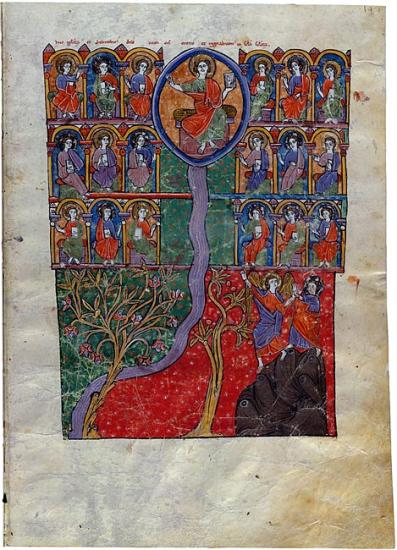
Christ Enthroned Over the River of Life
Beatus of Liébana
Las Huelgas Apocalypse
Purchased by Pierpont Morgan, 1910
He took me up a high mountain and showed me the river of the water of life, shining like crystal, proceeding from the throne of God and of the Lamb. In the midst of its main street, and on both sides of the river, was the Tree of Life, bearing twelve fruits, offering one for each month, and the leaves are for the health of the nations. But the throne of God and the Lamb will be in it, and his servants shall serve him. They shall see his face and his name shall be on their foreheads. Night shall be no more, and they will need neither lamp nor sun because the Lord God will illuminate them. And they shall reign forever and ever. (Rev. 22:1–5)
The enthroned figures holding books and acclaiming God are not mentioned in the text, but the inscription identifies them as "the people of God with whom he lives who will reign forever and ever."
The Apocalypse, or Book of Revelation, is not only the last Book of the New Testament, but its most difficult, puzzling, and terrifying. It provided challenges to medieval illustrators and was the source for a number of popular images, such as Christ in Majesty, the Adoration of the Lamb, and the Madonna of the Apocalypse and contributed to the widespread use of the Evangelists' symbols.
Selected images from Apocalypse Then: Medieval Illuminations from the Morgan, an exhibition held at the Morgan are presented here. The exhibition celebrates the completion of a facsimile of the Morgan's Las Huelgas Apocalypse—the latest dated (1220) and largest surviving manuscript of a Spanish tradition of illuminated commentaries on the Apocalypse by the monk Beatus of Liébana. The series of manuscripts constitutes Spain's most important contribution to medieval manuscript illumination.
The Las Huelgas Apocalypse contains three sections: the prefatory cycle, the Apocalypse, and the Book of Daniel.
In addition to forty-nine images from the Las Huelgas Apocalypse, six images from other manuscripts in the Morgan's collections, including the earliest Beatus painted by Maius and one by the Master of the Berry Apocalypse, are in this presentation.
Fol. 146v
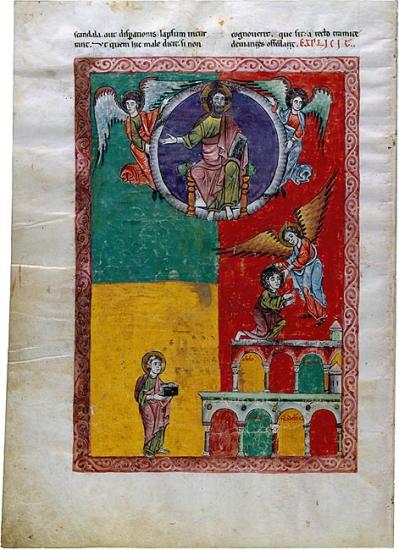
John, at the Feet of the Angel, Receives His Last Order
Beatus of Liébana
Las Huelgas Apocalypse
Purchased by Pierpont Morgan, 1910
He said to me: "These words are entirely faithful and true." And the Lord, the God of the spirits of the prophets, sent his angel to reveal to his servant what must occur soon: "For behold, I am approaching quickly! Blessed is he who keeps the words of the prophecy of this book." And I, John, after I had heard and seen, fell down in adoration before the feet of the angel. And he said to me: "Do not seal the words of the prophecy of this book. For the time is near. I am the Alpha and the Omega, the First and the Last, the Beginning and the End." Blessed are those who wash their robes in the blood of the Lamb, for they have a right to the tree of life and may enter through the gates into the city. I, Jesus, have sent my angel to testify to these things for you among the Churches. (Rev. 22:6–16)
The Apocalypse ends with this final illustration, a reconfirmation of the original command to John to record his visions and transmit the explanations to the seven churches of Asia Minor.
The Apocalypse, or Book of Revelation, is not only the last Book of the New Testament, but its most difficult, puzzling, and terrifying. It provided challenges to medieval illustrators and was the source for a number of popular images, such as Christ in Majesty, the Adoration of the Lamb, and the Madonna of the Apocalypse and contributed to the widespread use of the Evangelists' symbols.
Selected images from Apocalypse Then: Medieval Illuminations from the Morgan, an exhibition held at the Morgan are presented here. The exhibition celebrates the completion of a facsimile of the Morgan's Las Huelgas Apocalypse—the latest dated (1220) and largest surviving manuscript of a Spanish tradition of illuminated commentaries on the Apocalypse by the monk Beatus of Liébana. The series of manuscripts constitutes Spain's most important contribution to medieval manuscript illumination.
The Las Huelgas Apocalypse contains three sections: the prefatory cycle, the Apocalypse, and the Book of Daniel.
In addition to forty-nine images from the Las Huelgas Apocalypse, six images from other manuscripts in the Morgan's collections, including the earliest Beatus painted by Maius and one by the Master of the Berry Apocalypse, are in this presentation.
Fol. 147
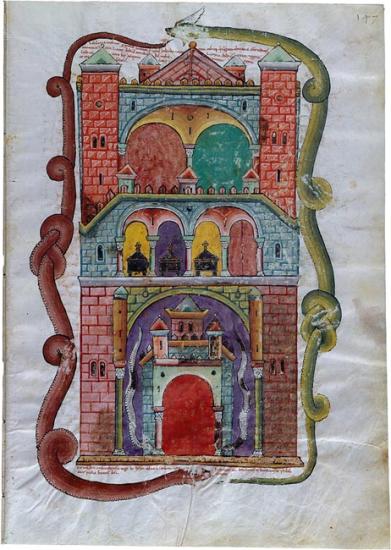
City of Babylon Surrounded by Serpents
Beatus of Liébana
Las Huelgas Apocalypse
Purchased by Pierpont Morgan, 1910
This miniature of Babylon functioned as a frontispiece to the Book of Daniel. It was from Babylon that Nebuchadnezzar came and besieged Jerusalem. The entire city of Babylon is surrounded by two enormous serpents whose heads and tails fall on the central axis. Two more serpents flank the large doorway at bottom. Above the door an arcade houses the silver coffins of the three Jews who were saved from the burning furnace; they are identified by the inscription at top as Hananiah, Mishael, and Azariah (and were worshiped as saints in Spain). The inscription below relates how Nebuchadnezzar took vessels from the temple of Jerusalem and how the wrath of God inflicted dragons, ostriches, and seductively singing owls and sirens on the city. Such accounts may have been inspired by the protective reliefs of dragons on Babylon's famous Ishtar Gate.
BOOK OF DANIEL
Although it was once thought that the author was Daniel, a Jewish exile in Babylon in the sixth century B.C., most scholars agree the book was written between 168 and 165 B.C. in support of Jews persecuted by the Seleucid emperor, Antiochus IV Epiphanes. The book was used as a pattern for later Jewish and Christian apocalypses, including the present Apocalypse of John, which also told of the fall of Babylon and the coming of Christ and his church. The Daniel cycle was added to Beatus manuscripts about 945, the same time that Maius introduced the prefatory cycle. The artist responsible for the eleven miniatures of the Las Huelgas Daniel cycle is called the Master of Toledo, after the city where he painted both manuscripts and frescoes. He participated in a copy of St. Ildefonsus's Treatise on the Virginity of Mary, now in Madrid (cod. 10087), and in wall paintings at the Basilica of Santa Cruz in Toledo. The Daniel cycle, however, was not invented for this manuscript but derives from earlier illustrated Bibles.
The Apocalypse, or Book of Revelation, is not only the last Book of the New Testament, but its most difficult, puzzling, and terrifying. It provided challenges to medieval illustrators and was the source for a number of popular images, such as Christ in Majesty, the Adoration of the Lamb, and the Madonna of the Apocalypse and contributed to the widespread use of the Evangelists' symbols.
Selected images from Apocalypse Then: Medieval Illuminations from the Morgan, an exhibition held at the Morgan are presented here. The exhibition celebrates the completion of a facsimile of the Morgan's Las Huelgas Apocalypse—the latest dated (1220) and largest surviving manuscript of a Spanish tradition of illuminated commentaries on the Apocalypse by the monk Beatus of Liébana. The series of manuscripts constitutes Spain's most important contribution to medieval manuscript illumination.
The Las Huelgas Apocalypse contains three sections: the prefatory cycle, the Apocalypse, and the Book of Daniel.
In addition to forty-nine images from the Las Huelgas Apocalypse, six images from other manuscripts in the Morgan's collections, including the earliest Beatus painted by Maius and one by the Master of the Berry Apocalypse, are in this presentation.
Fol. 151
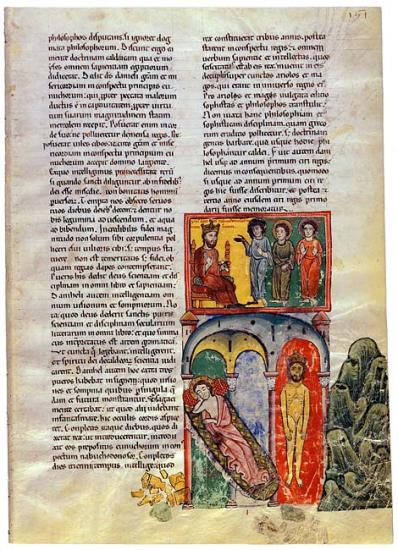
Nebuchadnezzar Dreams Of A Statue
Beatus of Liébana
Las Huelgas Apocalypse
Purchased by Pierpont Morgan, 1910
In the second year of Nebuchadnezzar's reign he had a terrifying dream, but it fled from him. But Daniel was able to tell the king that he saw a great and tall statue: the head was of the finest gold, but the breast and arms were of silver, the belly and thighs were of brass, the shins were of iron, and parts of the feet were of iron and others were clay. And that he saw a stone, broken off without hands from a mountain, shatter the statue; and the stone became a great mountain and filled the earth. Daniel then told him he was the head of gold, but that after him an inferior kingdom, of silver, would rise up, and then, one of brass, that would rule the world. And the fourth kingdom will be like iron. Just as iron shatters and conquers all things, so will it shatter and crush all these. (Dan. 1:40)
At the top Daniel addresses the king; below, Nebuchadnezzar dreams of the golden statue and its destruction by a stone that becomes a great mountain.
The Apocalypse, or Book of Revelation, is not only the last Book of the New Testament, but its most difficult, puzzling, and terrifying. It provided challenges to medieval illustrators and was the source for a number of popular images, such as Christ in Majesty, the Adoration of the Lamb, and the Madonna of the Apocalypse and contributed to the widespread use of the Evangelists' symbols.
Selected images from Apocalypse Then: Medieval Illuminations from the Morgan, an exhibition held at the Morgan are presented here. The exhibition celebrates the completion of a facsimile of the Morgan's Las Huelgas Apocalypse—the latest dated (1220) and largest surviving manuscript of a Spanish tradition of illuminated commentaries on the Apocalypse by the monk Beatus of Liébana. The series of manuscripts constitutes Spain's most important contribution to medieval manuscript illumination.
The Las Huelgas Apocalypse contains three sections: the prefatory cycle, the Apocalypse, and the Book of Daniel.
In addition to forty-nine images from the Las Huelgas Apocalypse, six images from other manuscripts in the Morgan's collections, including the earliest Beatus painted by Maius and one by the Master of the Berry Apocalypse, are in this presentation.
Fol. 154
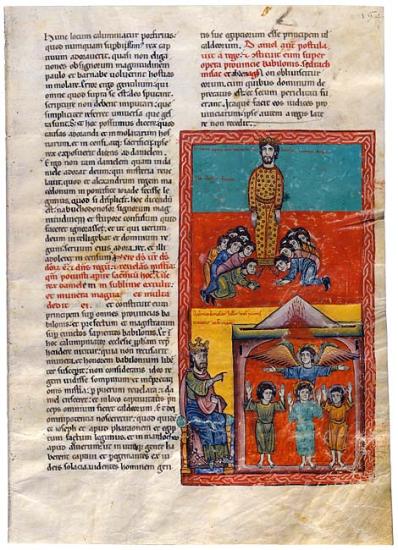
Adoration Of The Statue And The Hebrews In The Furnace
Beatus of Liébana
Las Huelgas Apocalypse
Purchased by Pierpont Morgan, 1910
King Nebuchadnezzar made a statue of gold, sixty cubits high and six cubits wide, and set it up in the plain of Dura in the province of Babylon. Then King Nebuchadnezzar dedicated the statue, and a herald proclaimed that when the music was heard, all must fall down and adore the gold statue; those who did not would be cast into a burning furnace. But Shadrach, Meshach, and Abednego [the names given to Hananiah, Mishael, and Azariah by the king's master of the eunuchs] could not obey, saying that their God could rescue them from the oven of burning fire and free them from his hands. And the furnace was heated so excessively that those who cast them in were themselves killed by the flames. But the three men walked in the flames, praising God and blessing the Lord. And the angel of the Lord descended into the furnace; and he cast the flame of the fire out of the furnace. And Hananiah, Mishael, and Azariah were freed. Nebuchadnezzar was amazed, saying, "Blessed is their God, who sent his angel and rescued his servants who believed in him." And they altered the king's verdict, so that they would not serve or adore any god except their God. (Dan. 3)
At the top Babylonians adore the statue that resembles the king below, who points to the angel driving out the fire. The three Hebrews, hands raised, sing their famous canticle of thanksgiving (Benedicite).
The Apocalypse, or Book of Revelation, is not only the last Book of the New Testament, but its most difficult, puzzling, and terrifying. It provided challenges to medieval illustrators and was the source for a number of popular images, such as Christ in Majesty, the Adoration of the Lamb, and the Madonna of the Apocalypse and contributed to the widespread use of the Evangelists' symbols.
Selected images from Apocalypse Then: Medieval Illuminations from the Morgan, an exhibition held at the Morgan are presented here. The exhibition celebrates the completion of a facsimile of the Morgan's Las Huelgas Apocalypse—the latest dated (1220) and largest surviving manuscript of a Spanish tradition of illuminated commentaries on the Apocalypse by the monk Beatus of Liébana. The series of manuscripts constitutes Spain's most important contribution to medieval manuscript illumination.
The Las Huelgas Apocalypse contains three sections: the prefatory cycle, the Apocalypse, and the Book of Daniel.
In addition to forty-nine images from the Las Huelgas Apocalypse, six images from other manuscripts in the Morgan's collections, including the earliest Beatus painted by Maius and one by the Master of the Berry Apocalypse, are in this presentation.
Fol. 159
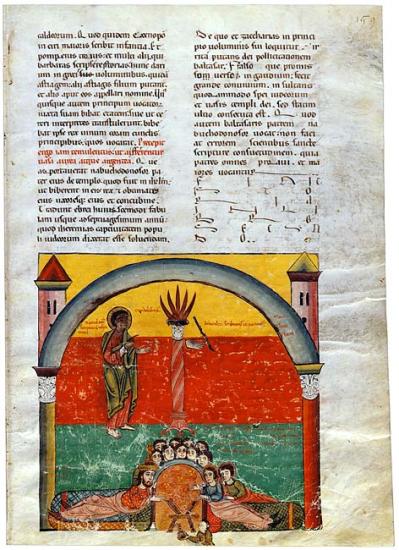
Feast Of Belshazzar
Beatus of Liébana
Las Huelgas Apocalypse
Purchased by Pierpont Morgan, 1910
Belshazzar, the king, made a great feast for a thousand of his nobles, and each of them drank according to his age. And when they were drunk, he had the gold and silver vessels that his father, Nebuchadnezzar, had carried away from the temple of Jerusalem, so that all, including concubines, drank from them. In the same hour, there appeared fingers, as of the hand of a man, writing on the wall opposite the candlestick. And the king became disturbed, saying that he who could read and interpret the writing would be clothed with purple, wear a golden chain on his neck, and be third in his kingdom. The queen suggested that Daniel be summoned, who said that Belshazzar, like his father, has not humbled his heart. Daniel then interpreted the three words. mane: "God has numbered your kingdom and has finished it"; thecel: "you have been weighed on the scales and found lacking"; phares: "your kingdom has been divided and has been given to the Medes and the Persians." The same night that Daniel received his rewards Belshazzar was killed, and Darius the Mede succeeded to his kingdom. (Dan. 5)
The king and his guests recline in beds, as in ancient times, while eating. Most are frowning, having heard the foreboding interpretations of the three mysterious words inscribed on the large arch framing the room.
The Apocalypse, or Book of Revelation, is not only the last Book of the New Testament, but its most difficult, puzzling, and terrifying. It provided challenges to medieval illustrators and was the source for a number of popular images, such as Christ in Majesty, the Adoration of the Lamb, and the Madonna of the Apocalypse and contributed to the widespread use of the Evangelists' symbols.
Selected images from Apocalypse Then: Medieval Illuminations from the Morgan, an exhibition held at the Morgan are presented here. The exhibition celebrates the completion of a facsimile of the Morgan's Las Huelgas Apocalypse—the latest dated (1220) and largest surviving manuscript of a Spanish tradition of illuminated commentaries on the Apocalypse by the monk Beatus of Liébana. The series of manuscripts constitutes Spain's most important contribution to medieval manuscript illumination.
The Las Huelgas Apocalypse contains three sections: the prefatory cycle, the Apocalypse, and the Book of Daniel.
In addition to forty-nine images from the Las Huelgas Apocalypse, six images from other manuscripts in the Morgan's collections, including the earliest Beatus painted by Maius and one by the Master of the Berry Apocalypse, are in this presentation.
Fol. 162
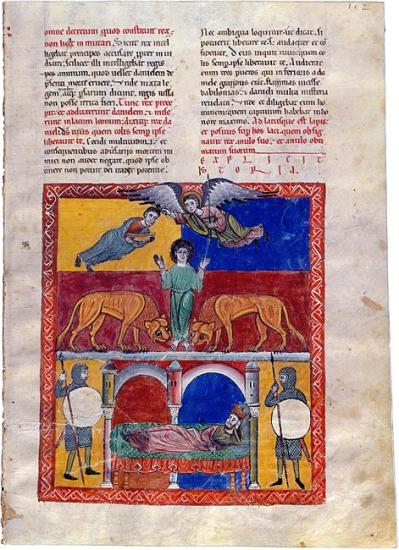
Daniel in the Lions' Den
Beatus of Liébana
Las Huelgas Apocalypse
Purchased by Pierpont Morgan, 1910
Darius appointed Daniel as one of three leaders to which the governors of the kingdom would be accountable. But others, envious of Daniel, had Darius publish a decree so that all who ask any petition of any god or man for thirty days will be cast into the den of lions. They then informed Darius that Daniel prayed three times daily, and the king had no choice but to cast him into the den of lions. The king said to Daniel, "Your God, whom you always serve, he himself will free you." And the king could not eat or sleep, going quickly to the den at sunrise. He tearfully cried out to Daniel, "Has your God freed you from the lions?" And Daniel answered, "O king, live forever. My God has sent his angel, who closed the mouths of the lions, and they have not harmed me, because before him justice has been found in me, and, even before you, O king, I have committed no offense." (Dan. 6)
Darius lies sleepless while Daniel's feet are licked by the lions. The hovering angel transports Habbakuk by the hair so that he can bring a bowl of food to Daniel. This episode is derived from earlier illustrated Bibles, as it is not mentioned in the manuscript. (It was later added to the Book of Daniel, at the end of the story of Bel and the Dragon; Dan. 14:32–36).
The Apocalypse, or Book of Revelation, is not only the last Book of the New Testament, but its most difficult, puzzling, and terrifying. It provided challenges to medieval illustrators and was the source for a number of popular images, such as Christ in Majesty, the Adoration of the Lamb, and the Madonna of the Apocalypse and contributed to the widespread use of the Evangelists' symbols.
Selected images from Apocalypse Then: Medieval Illuminations from the Morgan, an exhibition held at the Morgan are presented here. The exhibition celebrates the completion of a facsimile of the Morgan's Las Huelgas Apocalypse—the latest dated (1220) and largest surviving manuscript of a Spanish tradition of illuminated commentaries on the Apocalypse by the monk Beatus of Liébana. The series of manuscripts constitutes Spain's most important contribution to medieval manuscript illumination.
The Las Huelgas Apocalypse contains three sections: the prefatory cycle, the Apocalypse, and the Book of Daniel.
In addition to forty-nine images from the Las Huelgas Apocalypse, six images from other manuscripts in the Morgan's collections, including the earliest Beatus painted by Maius and one by the Master of the Berry Apocalypse, are in this presentation.
Fol. 163
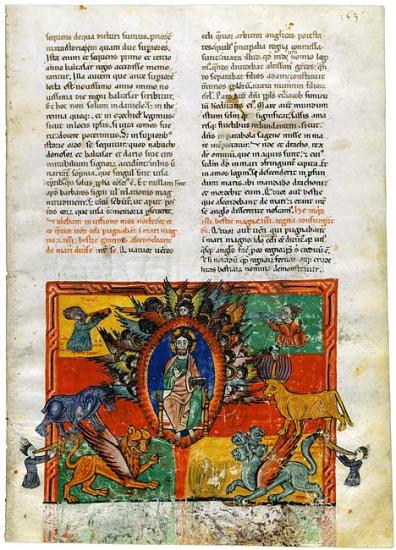
Vision Of The Elder Of Days And The Four Beasts
Beatus of Liébana
Las Huelgas Apocalypse
Purchased by Pierpont Morgan, 1910
In the first year of Belshazzar, king of Babylon, Daniel saw a dream: the four winds of the heavens fought upon the great sea, and four different great beasts rose from the sea. The first, like a lioness, had wings of an eagle; a beast, like a bear with three rows of teeth; another, like a leopard with wings and four heads; and a fourth, exceedingly strong, with great iron teeth, but with ten horns; and another little horn sprung up in the midst of the horns, with eyes like those of a man and a mouth speaking unnatural things. Then the ancient of days sat on the throne. The throne was flames of fire; and a river of fire rushed forth from his presence. Thousands upon thousands ministered to him. The trial began, and the books were opened. An attendant explained that "These four great beasts are four kingdoms, which will rise from the earth, yet it is the saints of the Most High God who will receive the kingdom, and they will hold the kingdom from this generation, and forever." And he said, "The fourth beast will be the fourth kingdom on earth, which will be greater than all the kingdoms, and will devour the whole earth, and will trample and crush it. And the ten horns will be ten kings, but another and mightier will rise up, and bring down three kings. (Dan. 7)
For Jerome, the four beasts were metaphors for the four ancient empires: the lioness represented Babylonia; the bear, Medes and the Persians; the leopard, Ptolemaic Egypt; and the beast with ten horns, Rome. The elder of the days is God. Note how the illuminator had begun to paint the bear and the fourth beast at the bottom but then whitened them out, squeezing them above the lioness and leopard. Apparently there was not enough space to give each beast its own compartment.
The Apocalypse, or Book of Revelation, is not only the last Book of the New Testament, but its most difficult, puzzling, and terrifying. It provided challenges to medieval illustrators and was the source for a number of popular images, such as Christ in Majesty, the Adoration of the Lamb, and the Madonna of the Apocalypse and contributed to the widespread use of the Evangelists' symbols.
Selected images from Apocalypse Then: Medieval Illuminations from the Morgan, an exhibition held at the Morgan are presented here. The exhibition celebrates the completion of a facsimile of the Morgan's Las Huelgas Apocalypse—the latest dated (1220) and largest surviving manuscript of a Spanish tradition of illuminated commentaries on the Apocalypse by the monk Beatus of Liébana. The series of manuscripts constitutes Spain's most important contribution to medieval manuscript illumination.
The Las Huelgas Apocalypse contains three sections: the prefatory cycle, the Apocalypse, and the Book of Daniel.
In addition to forty-nine images from the Las Huelgas Apocalypse, six images from other manuscripts in the Morgan's collections, including the earliest Beatus painted by Maius and one by the Master of the Berry Apocalypse, are in this presentation.
Fol. 167
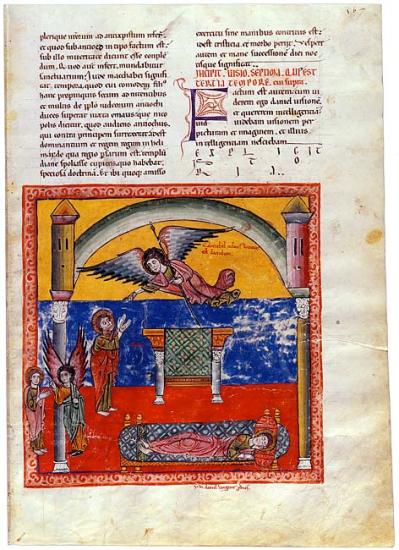
Gabriel Gives Daniel The Explanations, Daniel Languishes, And Gabriel Returns With Prophecies About The Future Of Jerusalem
Beatus of Liébana
Las Huelgas Apocalypse
Purchased by Pierpont Morgan, 1910
Gabriel explains the vision of the battle of the ram (king of the Medes and Persians) and the goat (king of the Greeks), after which Daniel languished for some days. I, Daniel, understood from the book of Jeremiah that the desolation of Jerusalem would be completed in seventy years. And I thus prayed and made supplication to the Lord my God that his anger and fury might be turned away from Jerusalem. And while I was still praying the man Gabriel, whom I had seen in the vision flying swiftly, touched me at the time of the evening sacrifice. Seventy weeks of years are concentrated on your people and holy city, so that transgression shall be finished, and sin shall reach an end, and iniquity shall be wiped away, and so that everlasting justice shall be brought in, and vision and prophecy shall be fulfilled, and the saint of saints shall be anointed. (Dan. 8–9)
At left, Gabriel explains the battles to Daniel, after which he retires to bed. Above, he returns as Daniel offers evening sacrifice at the altar.
The Apocalypse, or Book of Revelation, is not only the last Book of the New Testament, but its most difficult, puzzling, and terrifying. It provided challenges to medieval illustrators and was the source for a number of popular images, such as Christ in Majesty, the Adoration of the Lamb, and the Madonna of the Apocalypse and contributed to the widespread use of the Evangelists' symbols.
Selected images from Apocalypse Then: Medieval Illuminations from the Morgan, an exhibition held at the Morgan are presented here. The exhibition celebrates the completion of a facsimile of the Morgan's Las Huelgas Apocalypse—the latest dated (1220) and largest surviving manuscript of a Spanish tradition of illuminated commentaries on the Apocalypse by the monk Beatus of Liébana. The series of manuscripts constitutes Spain's most important contribution to medieval manuscript illumination.
The Las Huelgas Apocalypse contains three sections: the prefatory cycle, the Apocalypse, and the Book of Daniel.
In addition to forty-nine images from the Las Huelgas Apocalypse, six images from other manuscripts in the Morgan's collections, including the earliest Beatus painted by Maius and one by the Master of the Berry Apocalypse, are in this presentation.
Fol. 172v
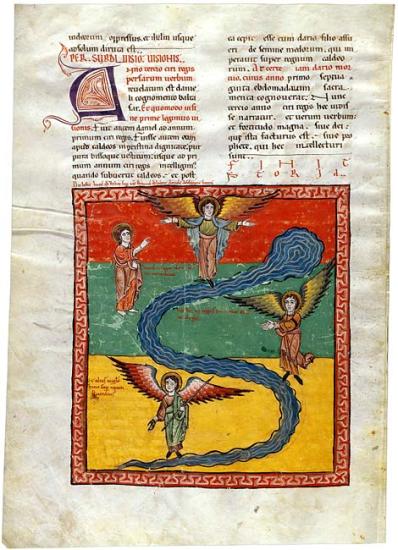
Daniel Sees Three Angels By The Tigris
Beatus of Liébana
Las Huelgas Apocalypse
Purchased by Pierpont Morgan, 1910
In the third year of Cyrus, king of the Persians, a message was revealed to Daniel. I, Daniel, was next to the great Tigris river, and saw a man clothed in linen, and his waist was wrapped with the finest gold, and his face was like lightning and his eyes like a burning lamp. And he said, "I have come to teach you what will happen to your people in the latter days, because the vision is for a long time from now. But Daniel, close the message and seal the book, until the established time." And then I saw two others who stood up, one on each bank of the river. And I said to the man clothed in linen, "How long will it be until the end of these wonders?" And the man lifted both hands toward heaven, saying, when the band of holy people is completely dispersed. (Dan. 10–12)
The angel at the top, his arms raised, is the one clothed in linen (although the artist did not follow the biblical description). The two men on the banks of the Tigris are the two smaller angels.
The Apocalypse, or Book of Revelation, is not only the last Book of the New Testament, but its most difficult, puzzling, and terrifying. It provided challenges to medieval illustrators and was the source for a number of popular images, such as Christ in Majesty, the Adoration of the Lamb, and the Madonna of the Apocalypse and contributed to the widespread use of the Evangelists' symbols.
Selected images from Apocalypse Then: Medieval Illuminations from the Morgan, an exhibition held at the Morgan are presented here. The exhibition celebrates the completion of a facsimile of the Morgan's Las Huelgas Apocalypse—the latest dated (1220) and largest surviving manuscript of a Spanish tradition of illuminated commentaries on the Apocalypse by the monk Beatus of Liébana. The series of manuscripts constitutes Spain's most important contribution to medieval manuscript illumination.
The Las Huelgas Apocalypse contains three sections: the prefatory cycle, the Apocalypse, and the Book of Daniel.
In addition to forty-nine images from the Las Huelgas Apocalypse, six images from other manuscripts in the Morgan's collections, including the earliest Beatus painted by Maius and one by the Master of the Berry Apocalypse, are in this presentation.
Fols. 129v–130
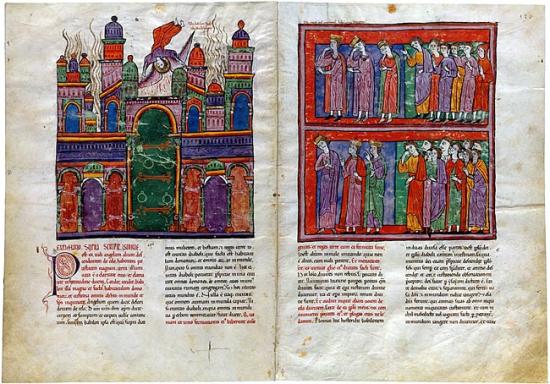
Burning of Babylon and the Mourning Kings and Merchants
Beatus of Liébana
Las Huelgas Apocalypse
Purchased by Pierpont Morgan, 1910
And I saw another angel descending from heaven, saying: "Fallen, fallen is Babylon the great. And she has become the habitation of demons, and the keepsake of every unclean spirit, and the possession of every unclean and hateful flying thing." For this reason her afflictions shall arrive in one day: death and grief and famine. And she shall be burned with fire. And the kings of the earth, who have fornicated with her and lived in luxury, shall weep and mourn for themselves over her, when they see the smoke of her conflagration, standing far away, out of fear of her torments, saying: "Woe! Woe! to Babylon, that great and strong city. For in one hour, your judgment has arrived." And the businessmen of the earth shall weep and mourn over her, because no one will buy their merchandise anymore. (Rev. 18:1–11)
The splendid city of Babylon—engulfed in flames—is a symbol of Satan and of all evil. The mourning kings (wearing gold crowns of a type popular about 1220) and merchants grimace and gesture in despair.
The Apocalypse, or Book of Revelation, is not only the last Book of the New Testament, but its most difficult, puzzling, and terrifying. It provided challenges to medieval illustrators and was the source for a number of popular images, such as Christ in Majesty, the Adoration of the Lamb, and the Madonna of the Apocalypse and contributed to the widespread use of the Evangelists' symbols.
Selected images from Apocalypse Then: Medieval Illuminations from the Morgan, an exhibition held at the Morgan are presented here. The exhibition celebrates the completion of a facsimile of the Morgan's Las Huelgas Apocalypse—the latest dated (1220) and largest surviving manuscript of a Spanish tradition of illuminated commentaries on the Apocalypse by the monk Beatus of Liébana. The series of manuscripts constitutes Spain's most important contribution to medieval manuscript illumination.
The Las Huelgas Apocalypse contains three sections: the prefatory cycle, the Apocalypse, and the Book of Daniel.
In addition to forty-nine images from the Las Huelgas Apocalypse, six images from other manuscripts in the Morgan's collections, including the earliest Beatus painted by Maius and one by the Master of the Berry Apocalypse, are in this presentation.
Fols. 149v–150
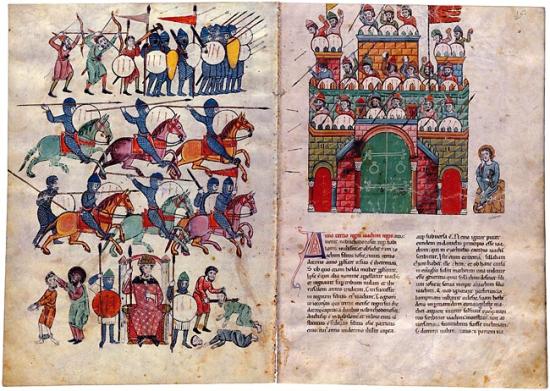
Siege of Jerusalem
Beatus of Liébana
Las Huelgas Apocalypse
Purchased by Pierpont Morgan, 1910
In the third year of the reign of Jehoiakim king of Judah, Nebuchadnezzar king of Babylon came to Jerusalem and besieged it. (Dan. 1:1)
This miniature actually illustrates an earlier siege in which Nebuchadnezzar captured Jerusalem and, on the plain of Jericho, the escaping King Sedecias of Judah. At the bottom left sits the enthroned Nebuchadnezzar, flanked by guards in thirteenth-century armor; he directs the blinding of Sedecias and the killing of his sons (4 Kings 25:1–7). On the opposite page, Jeremiah, seated outside the city, laments the fall of Jerusalem and defeat of the Israelites.
The Apocalypse, or Book of Revelation, is not only the last Book of the New Testament, but its most difficult, puzzling, and terrifying. It provided challenges to medieval illustrators and was the source for a number of popular images, such as Christ in Majesty, the Adoration of the Lamb, and the Madonna of the Apocalypse and contributed to the widespread use of the Evangelists' symbols.
Selected images from Apocalypse Then: Medieval Illuminations from the Morgan, an exhibition held at the Morgan are presented here. The exhibition celebrates the completion of a facsimile of the Morgan's Las Huelgas Apocalypse—the latest dated (1220) and largest surviving manuscript of a Spanish tradition of illuminated commentaries on the Apocalypse by the monk Beatus of Liébana. The series of manuscripts constitutes Spain's most important contribution to medieval manuscript illumination.
The Las Huelgas Apocalypse contains three sections: the prefatory cycle, the Apocalypse, and the Book of Daniel.
In addition to forty-nine images from the Las Huelgas Apocalypse, six images from other manuscripts in the Morgan's collections, including the earliest Beatus painted by Maius and one by the Master of the Berry Apocalypse, are in this presentation.
Fols. 184v, 183
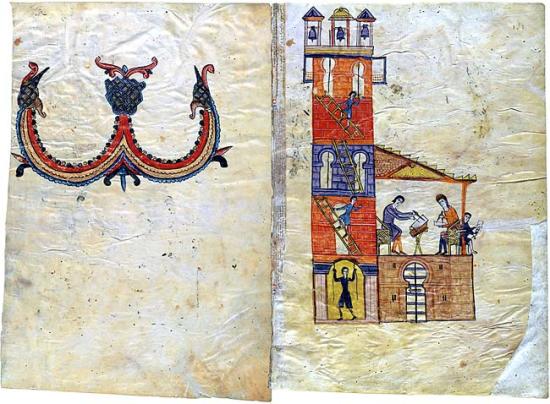
Omega And The Tower Scriptorium Of Tábara
Beatus of Liébana
Las Huelgas Apocalypse
Purchased by Pierpont Morgan, 1910
In the Apocalypse Christ refers to himself several times as the Alpha and Omega. Thus some Beatus manuscripts begin and end with monumental images of those two Greek letters. When the Morgan manuscript was rebound during the seventeenth century, the final bifolio containing the omega and the tower was turned inside out by the binder, who thought he was correcting a previous mistake. Thus the omega incorrectly ended up as the last illustration. Now, for the first time since then, the original order of these last two images has been restored. The representation of the celebrated scriptorium of San Salvador de Tábara was copied from a Beatus manuscript completed in Tábara in 970. The two images are the earliest "portraits" of a medieval scriptorium in a manuscript. It shows the scribe and illuminator laying out their folios, while a novice trims parchment. In the tower, three men ring the bells, which functioned as the community's clock.
The Apocalypse, or Book of Revelation, is not only the last Book of the New Testament, but its most difficult, puzzling, and terrifying. It provided challenges to medieval illustrators and was the source for a number of popular images, such as Christ in Majesty, the Adoration of the Lamb, and the Madonna of the Apocalypse and contributed to the widespread use of the Evangelists' symbols.
Selected images from Apocalypse Then: Medieval Illuminations from the Morgan, an exhibition held at the Morgan are presented here. The exhibition celebrates the completion of a facsimile of the Morgan's Las Huelgas Apocalypse—the latest dated (1220) and largest surviving manuscript of a Spanish tradition of illuminated commentaries on the Apocalypse by the monk Beatus of Liébana. The series of manuscripts constitutes Spain's most important contribution to medieval manuscript illumination.
The Las Huelgas Apocalypse contains three sections: the prefatory cycle, the Apocalypse, and the Book of Daniel.
In addition to forty-nine images from the Las Huelgas Apocalypse, six images from other manuscripts in the Morgan's collections, including the earliest Beatus painted by Maius and one by the Master of the Berry Apocalypse, are in this presentation.
Other Manuscripts
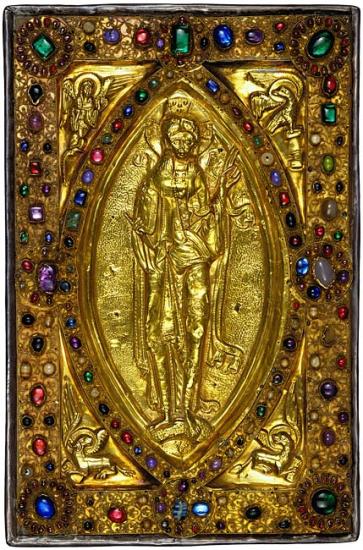
Christ In Majesty With The Four Living Creatures
Flanders, third quarter of the eleventh century, for Judith, countess of Flanders. On a Gospel Book, in Latin.
The popular theme of Christ in Majesty surrounded by the four symbols of the evangelists (eagle, man, lion, ox) is based on John's vision of the throne of heaven with the four living creatures (Rev. 4). His vision, in turn, was inspired by that of Ezechiel, where cherubim supported the throne chariot of God.
The Apocalypse, or Book of Revelation, is not only the last Book of the New Testament, but its most difficult, puzzling, and terrifying. It provided challenges to medieval illustrators and was the source for a number of popular images, such as Christ in Majesty, the Adoration of the Lamb, and the Madonna of the Apocalypse and contributed to the widespread use of the Evangelists' symbols.
Selected images from Apocalypse Then: Medieval Illuminations from the Morgan, an exhibition held at the Morgan are presented here. The exhibition celebrates the completion of a facsimile of the Morgan's Las Huelgas Apocalypse—the latest dated (1220) and largest surviving manuscript of a Spanish tradition of illuminated commentaries on the Apocalypse by the monk Beatus of Liébana. The series of manuscripts constitutes Spain's most important contribution to medieval manuscript illumination.
The Las Huelgas Apocalypse contains three sections: the prefatory cycle, the Apocalypse, and the Book of Daniel.
In addition to forty-nine images from the Las Huelgas Apocalypse, six images from other manuscripts in the Morgan's collections, including the earliest Beatus painted by Maius and one by the Master of the Berry Apocalypse, are in this presentation.
MS M.644 (fols. 86v–87)
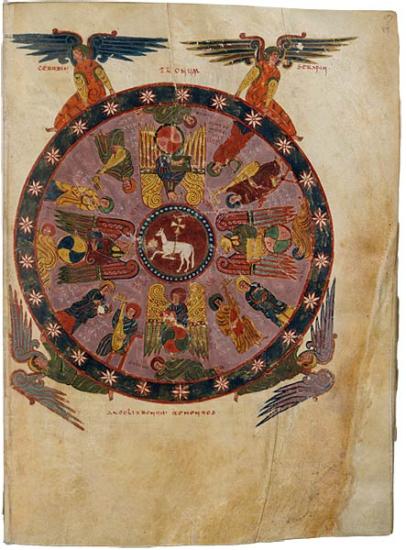
The Vision of the Lamb
This page is from one of the earliest surviving illuminated manuscripts in the Spanish tradition. Written and illuminated by Maius (ca. 945) in the famous tower scriptorium of the monastery of San Salvador de Tabara, it is the most important Spanish illuminated manuscript in the United States.
At the center of the composition is a cross-bearing Lamb, the symbol of Christ. The Lamb is surrounded at the four cardinal points by the living creatures, holding books. A century later these creatures were interpreted as the symbols of the four evangelists (the eagle is John; the lion, Mark; the man, Matthew; and the ox, Luke). Between the creatures are adoring ancients with four-stringed gitterns and vials. Four angels hold the outer border of twenty-four stars. The miniature is one of the finest by Maius, who both wrote and painted this book, a masterpiece of Mozarabic illumination and the earliest complete Spanish Apocalypse.
The Apocalypse, or Book of Revelation, is not only the last Book of the New Testament, but its most difficult, puzzling, and terrifying. It provided challenges to medieval illustrators and was the source for a number of popular images, such as Christ in Majesty, the Adoration of the Lamb, and the Madonna of the Apocalypse and contributed to the widespread use of the Evangelists' symbols.
Selected images from Apocalypse Then: Medieval Illuminations from the Morgan, an exhibition held at the Morgan are presented here. The exhibition celebrates the completion of a facsimile of the Morgan's Las Huelgas Apocalypse—the latest dated (1220) and largest surviving manuscript of a Spanish tradition of illuminated commentaries on the Apocalypse by the monk Beatus of Liébana. The series of manuscripts constitutes Spain's most important contribution to medieval manuscript illumination.
The Las Huelgas Apocalypse contains three sections: the prefatory cycle, the Apocalypse, and the Book of Daniel.
In addition to forty-nine images from the Las Huelgas Apocalypse, six images from other manuscripts in the Morgan's collections, including the earliest Beatus painted by Maius and one by the Master of the Berry Apocalypse, are in this presentation.
MS M.1079, fols. 6v–7
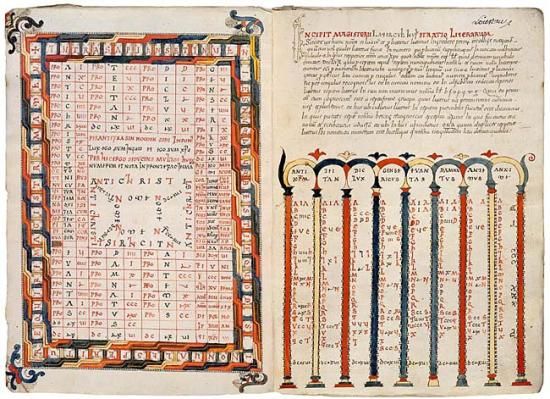
Two Antichrist Tables
Miscellaneous documents, letters, and treatises in Spanish, Latin, and Greek relating to Aragon, as well as seven watercolors after the Fanlo Beatus.
These watercolors, commissioned by Vincenio de Lastanosa of Huesca in 1635, are copies of a now lost Beatus then in the monastery of Montearagón. The original manuscript was a gift of King Ramiro I of Aragon (1035–1064) to Abbot Banzo of the monastery of San Andrés de Fanlo. It probably originated at the monastery of San Millán de la Cogolla in La Rioja, for it copies the Escorial Beatus that was made there.
Although the Apocalypse text does not include Antichrist tables, Beatus supplied them to simplify calculating the number of the Beast from the names for the Antichrist. In the first table the names are written vertically in black: Antichrist is first (followed by three other names in columns 5, 8, and 11). Each letter is given a numeric value in red in the next column. There are three more names in the bottom part. The second table is clearer. Antichrist, along with his seven other names, is inscribed below the arches (Teitan, Diclux, Gensericus, Evantas, Damnatus, Antemus, and Anxime). The alphabet beneath each name gives the numeric value of each letter. Added up, the numbers of each column yield 666 (DCLXVI at the bottom).
The Apocalypse, or Book of Revelation, is not only the last Book of the New Testament, but its most difficult, puzzling, and terrifying. It provided challenges to medieval illustrators and was the source for a number of popular images, such as Christ in Majesty, the Adoration of the Lamb, and the Madonna of the Apocalypse and contributed to the widespread use of the Evangelists' symbols.
Selected images from Apocalypse Then: Medieval Illuminations from the Morgan, an exhibition held at the Morgan are presented here. The exhibition celebrates the completion of a facsimile of the Morgan's Las Huelgas Apocalypse—the latest dated (1220) and largest surviving manuscript of a Spanish tradition of illuminated commentaries on the Apocalypse by the monk Beatus of Liébana. The series of manuscripts constitutes Spain's most important contribution to medieval manuscript illumination.
The Las Huelgas Apocalypse contains three sections: the prefatory cycle, the Apocalypse, and the Book of Daniel.
In addition to forty-nine images from the Las Huelgas Apocalypse, six images from other manuscripts in the Morgan's collections, including the earliest Beatus painted by Maius and one by the Master of the Berry Apocalypse, are in this presentation.
MS M.644 (fols. 219v–20)
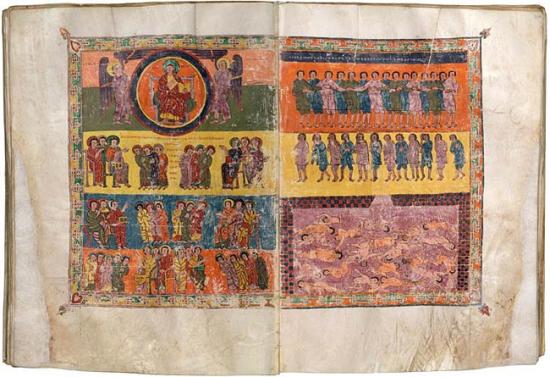
Last Judgment (Rev.: 20:11–15)
These pages are from one of the earliest surviving illuminated manuscripts in the Spanish tradition. Written and illuminated by Maius (ca. 945) in the famous tower scriptorium of the monastery of San Salvador de Tabara, it is the most important Spanish illuminated manuscript in the United States.
Christ the Judge sits at the top in a mandorla supported by two angels. Below, in three registers, are six pairs of seated saints (probably apostles), each pair with a saint standing behind. These bless the elect, represented by groups of nimbed saints. The registers at right contain the damned. The men at the top clasping hands are those damned together; below, men suffer individually; at bottom, the damned are tortured in a lake of fire with ovenlike walls. Maius tells us that he made this book so that the "wise may fear the coming of the future judgment of the world's end." The use of bands of color and miniatures extending over two pages represent Maius's contribution to the Beatus tradition.
The Apocalypse, or Book of Revelation, is not only the last Book of the New Testament, but its most difficult, puzzling, and terrifying. It provided challenges to medieval illustrators and was the source for a number of popular images, such as Christ in Majesty, the Adoration of the Lamb, and the Madonna of the Apocalypse and contributed to the widespread use of the Evangelists' symbols.
Selected images from Apocalypse Then: Medieval Illuminations from the Morgan, an exhibition held at the Morgan are presented here. The exhibition celebrates the completion of a facsimile of the Morgan's Las Huelgas Apocalypse—the latest dated (1220) and largest surviving manuscript of a Spanish tradition of illuminated commentaries on the Apocalypse by the monk Beatus of Liébana. The series of manuscripts constitutes Spain's most important contribution to medieval manuscript illumination.
The Las Huelgas Apocalypse contains three sections: the prefatory cycle, the Apocalypse, and the Book of Daniel.
In addition to forty-nine images from the Las Huelgas Apocalypse, six images from other manuscripts in the Morgan's collections, including the earliest Beatus painted by Maius and one by the Master of the Berry Apocalypse, are in this presentation.
MS M.240, fols. 3v–4
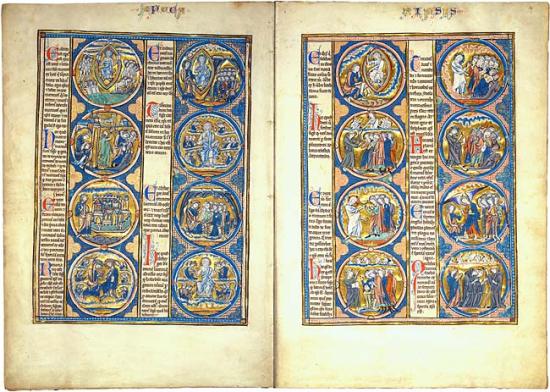
Moralized Bible, in Latin
The present fragment was originally the final portion of a three-volume Moralized Bible now in Toledo Cathedral, Spain. Each page contains two columns of roundels, totaling some 5,000 illuminations. The roundels alternately depict the biblical excerpts and the commentaries. Altogether there are 156 images illustrating biblical excerpts and another 156 the commentaries, making this the richest Apocalypse cycle ever conceived.
The Apocalypse, or Book of Revelation, is not only the last Book of the New Testament, but its most difficult, puzzling, and terrifying. It provided challenges to medieval illustrators and was the source for a number of popular images, such as Christ in Majesty, the Adoration of the Lamb, and the Madonna of the Apocalypse and contributed to the widespread use of the Evangelists' symbols.
Selected images from Apocalypse Then: Medieval Illuminations from the Morgan, an exhibition held at the Morgan are presented here. The exhibition celebrates the completion of a facsimile of the Morgan's Las Huelgas Apocalypse—the latest dated (1220) and largest surviving manuscript of a Spanish tradition of illuminated commentaries on the Apocalypse by the monk Beatus of Liébana. The series of manuscripts constitutes Spain's most important contribution to medieval manuscript illumination.
The Las Huelgas Apocalypse contains three sections: the prefatory cycle, the Apocalypse, and the Book of Daniel.
In addition to forty-nine images from the Las Huelgas Apocalypse, six images from other manuscripts in the Morgan's collections, including the earliest Beatus painted by Maius and one by the Master of the Berry Apocalypse, are in this presentation.
MS M.133v (fol. 57v)
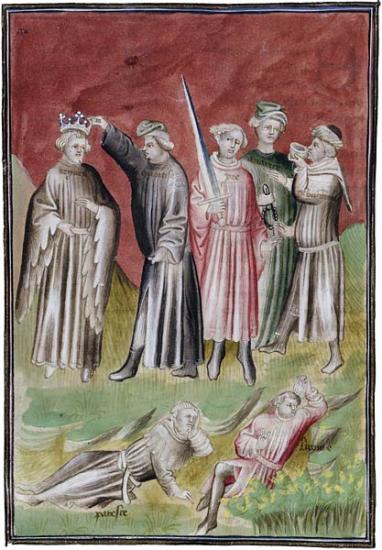
Seven Deadly Sins as the Seven Plagues
Apocalypse, with the commentary of Berengaudus, in French by the Master of the Berry Apocalypse
The seven plagues, following the commentary by Berengaudus (fl. 840–92), are interpreted as the Seven Deadly Sins, which some believed would take over the world as the end neared. Envy places a crown on Pride, Anger holds a sword, Avarice has a purse, and Gluttony drinks. Sloth is recumbent and Lust combs his hair. The manuscript was in the library of Jean, duc de Berry, the great French bibliophile who commissioned the Très Riches Heures. The anonymous artist responsible for its 85 miniatures was named the Master of the Berry Apocalypse after this book.
The Apocalypse, or Book of Revelation, is not only the last Book of the New Testament, but its most difficult, puzzling, and terrifying. It provided challenges to medieval illustrators and was the source for a number of popular images, such as Christ in Majesty, the Adoration of the Lamb, and the Madonna of the Apocalypse and contributed to the widespread use of the Evangelists' symbols.
Selected images from Apocalypse Then: Medieval Illuminations from the Morgan, an exhibition held at the Morgan are presented here. The exhibition celebrates the completion of a facsimile of the Morgan's Las Huelgas Apocalypse—the latest dated (1220) and largest surviving manuscript of a Spanish tradition of illuminated commentaries on the Apocalypse by the monk Beatus of Liébana. The series of manuscripts constitutes Spain's most important contribution to medieval manuscript illumination.
The Las Huelgas Apocalypse contains three sections: the prefatory cycle, the Apocalypse, and the Book of Daniel.
In addition to forty-nine images from the Las Huelgas Apocalypse, six images from other manuscripts in the Morgan's collections, including the earliest Beatus painted by Maius and one by the Master of the Berry Apocalypse, are in this presentation.
